Thinking about adding rabbits to your family, or wanting to deepen your understanding of these lively pets? Learn everything you need to know about bunnies in rabbit care 101. From their care to navigating their personalities, here’s the scoop on keeping rabbits healthy and happy to forge bunny-bonds that will last a lifetime.
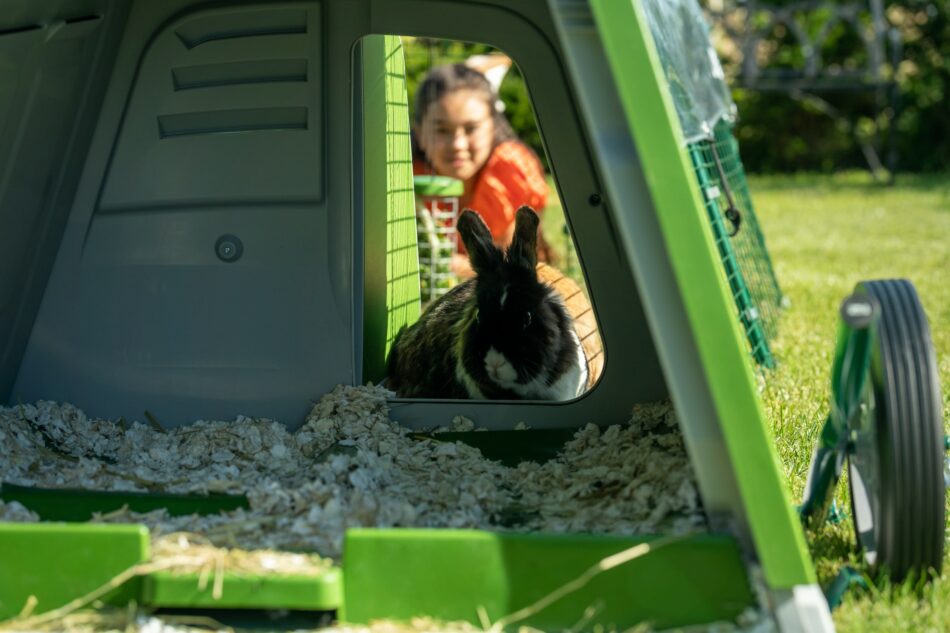
Rabbits as pets
There are many things to love about having rabbits as pets. Rabbits are intelligent and emotional animals that bring a lot of personality and character to the lives of their families. They’re energetic, enigmatic, and entertaining companions to their owners. While beginners can care for rabbits, their strong legs and quick movements warrant the need for older primary caregivers. Children can enjoy watching their bunnies bound and play in their setup, or sit with them for visits and playtime.
Like other pets, rabbits each have their own personalities. Some may be inclined to sit and snuggle, while others prefer to display their affection through avid play. No matter what kind of bunny you bring home, their setup will need to be safe and supportive. Learn how to set up for success with your rabbits, and how to care for them to help them live their best lives.
Diet
Did you know that the digestive system of a rabbit actually resembles that of a horse? They have an organ called the “cecum” that acts much like a rumen of a cow — but instead of it being at the beginning of their digestive tract like cows, it’s at the end like a horse. Because rabbits have cecums, and because of its location, they need quality fiber in their diet to keep this microbe-rich organ working properly.
The majority of your rabbits’ diet — around 85% — should be in the form of high quality hay. Timothy hay is a popular, healthy choice that is readily available, and should be offered free-choice. Other hay options for your bunnies include:
- Orchard Grass Hay
- Oat Hay
- Meadow Hay
In addition to free-choice hay, you should offer your bunnies a small amount of feed pellets each day. Each rabbit requires a different amount of feed based on their age, breed, and size, but a general rule of thumb is around ¼ cup per 5 lb rabbit a day. The remainder of your bunnies’ nutrition should come from fresh veggies — preferably leafy greens. Small amounts of fruit can be offered once or twice a week, but should be given as treats and not part of their usual diet.
Along with their food, your rabbits will also need fresh water daily. Hydration is a vital part of bunny digestion, and is essential for keeping their bodies regulated. You can offer water in a bottle that hangs inside of your rabbits’ hutch or in a shady part of their run. But some owners find that their bunnies drink more from a crock or a bowl. Depending on how many rabbits you have and how much they drink you may need to provide multiple water sources throughout their setup — especially in warmer weather.
Housing
Rabbits thrive in as much space as possible, and feel most at home in their natural element. Domesticated rabbits share many behaviours and instincts with their wild counterparts, but need the space and setting to support them. This is why housing your rabbits outdoors is the best option.*
The rocky relationship between rabbits and gardens is what most people may call to mind when they think of outdoor bunnies. But while this notion has some merit, the right setup and planning can ensure that your rabbits can live in harmony with your landscaping. The other concern with keeping rabbits outdoors is the threat of predators. And while this is indeed a reality that most rabbit owners will face, predators can be thwarted with the right setup.
To provide a safe, supportive environment for your rabbit outside, they will need:
These bunny-basics will enable your rabbits to live outside all year round, and thrive in their element while being protected from the elements. Expect to spot clean your rabbits’ hutch daily, with a deep cleaning once a week. Choose absorbent bedding like pine shavings or pellets during the summer months, and opt for warmer options like straw during the winter.
*Some rabbits have special considerations that may require them to be kept in a more climate controlled environment, especially during extreme weather and temperatures. This is true for rabbits that have:
- Thick coats like Angoras
- Underlying health conditions or injuries
- Trouble regulating their temperature, like very young or very old rabbits
Social needs
In the wild, rabbits live in large groups called colonies. They create extensive tunnels and burrows that make up their warrens, and interact with each other throughout the day. This social structure provides safety and satisfies the need for interaction. Similarly, most pet rabbits feel most comfortable when they have a companion.
Rabbits should be kept in pairs, with few bunnies being an exception. More territorial rabbits may need to be housed alone, and intact males should never be kept together. The easiest, most natural pairing is a neutered male with a female (even better if the female is spayed). Other successful pairings include females or neutered males, but they should ideally be littermates raised together, or introduced at a young age. Introducing older rabbits is possible, but it takes more time and a practiced hand.
While rabbits kept in pairs are usually happier than those housed alone, bunnies also benefit from interacting with their humans. They’re capable of forming close bonds with their caretakers, similar to those of dogs and cats. You’ll see your rabbits grooming each other, sleeping together, or playing a game of chase, but they’ll soon recognise you as the bringer-of-food and back-scratcher-extraordinaire. Aim to spend at least 20 minutes a day with your rabbit. Playing games with your rabbits or simply sitting with them every day will go a long way in building a bond that will last a lifetime.
Healthcare
When properly cared for, rabbits are healthy, hardy animals. In addition to their housing and diet, here are some healthcare considerations for pet rabbits:
- Brushing their coats and trimming their nails as needed
- Establishing care with a veterinarian that is familiar with treating rabbits
- Having them spayed or neutered at the appropriate age
Deworming and vaccination options for rabbits vary depending on your location, so it’s important to discuss these with your veterinarian.
Rabbits also have incisors that grow continuously, so providing hay and other chewing elements will help keep their teeth in check. If your rabbits don’t have enough to gnaw on, they may need to have their teeth trimmed by a veterinarian.
Flystrike in rabbits is a condition that outdoor rabbits should be monitored for. While uncommon in healthy, well-cared for rabbits, flystrike can cause serious illness. Performing regular rabbit health checks and keeping their hutch and run clean will help prevent flystrike.
Other considerations
While not necessarily a necessity, accessories can elevate your bunnies’ — and your — experience. Consider adding these fun and engaging elements to your rabbits’ setup:
These accessories have been designed to foster natural behaviours of rabbits, and provide endless opportunities for exercise and excitement.
Omlet and your rabbits
Keeping rabbits as pets is a rewarding experience that can provide years of close companionship. With Omlet, your rabbits can thrive outside in their natural environment while helping you with your workload. Our easy-to-clean rabbit hutches and spacious rabbit runs make caring for your rabbits a breeze. And, with exciting rabbit accessories, you can round out their setup to create the ultimate bunny abode. So, are you ready for rabbits? Choose Omlet for your rabbits, and keep them confidently for years to come.
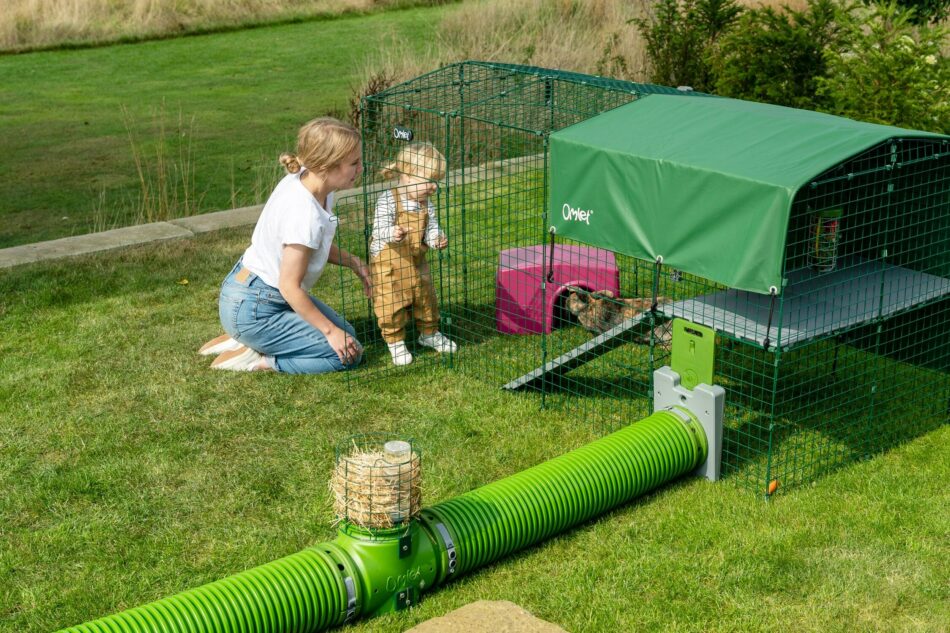

This entry was posted in Rabbits
Rabbits are often the villains in gardening tales — both in fiction and first-hand accounts. But with just some minor modifications, bunnies can actually be beneficial to gardens. We’re here to set the record straight: gardening with rabbits is both possible and enjoyable with the right setup and know-how.
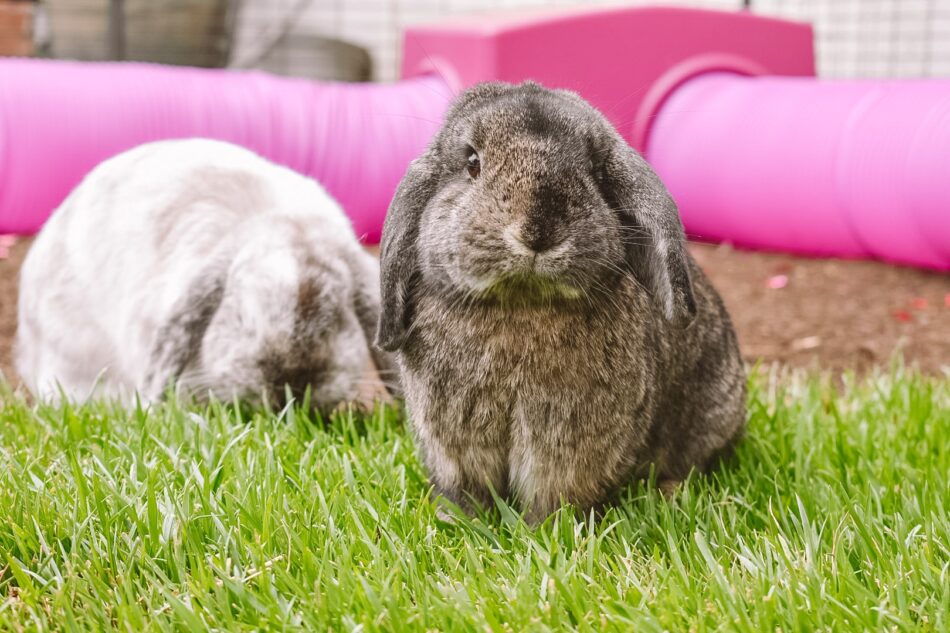
Bunnies and gardens: how to keep both
The beloved tale of Peter Rabbit by Beatrix Potter paints a pretty bleak picture of life with rabbits in gardens. Both Mr. McGregor’s plants and person were afflicted by the endearing mischief-making Peter. This story, along with many others, have earned rabbits quite the reputation for being garden menaces.
While it’s true that — when left to their own devices — rabbits will happily nibble, gnaw, and devour a number of garden plants, they’re merely acting out of instinct. Here’s how to keep your bunnies alongside your garden without risking your prized blooms and buds.
Setup for success
Rabbits need their own space in or around the garden to keep them from sampling (or decimating) its contents. And, plants should be placed in elevated containers or garden beds to prevent rabbits — both wild and domestic — from reaching them. If a plant is within reach of your rabbits, it’s fair game.
Strategically placing your rabbit hutch and run in proximity to your garden will help you reap the benefits of bunnies — or more specifically, their droppings. Rabbit manure is gardening gold, and can be added directly to plants without needing to be composted first.
Rabbits can also eat potential unwanted plants in the garden like dandelions or clover, and with wheels and handles for your rabbit hutch, you can move their home around to direct their weed-eating services. You can also create separate areas by using Zippi Rabbit Tunnels and Playpens to target specific areas that are prone to overgrowth.
Plant with purpose
Deciding what type of garden you want to have will help you choose the plants you incorporate. Some plants are naturally more appetising to rabbits than others, while others have odours or textures that rabbits may find off putting. You can grow healthy snacks and treats in a rabbit-friendly garden, or you can plant vegetation that doesn’t appeal to bunnies — avoiding drawing their attention altogether.
Rabbit-friendly garden options
- Arugula
- Asters
- Bell Pepper
- Carnations
- Carrots
- Geraniums
- Greens (mustard, turnip, etc.)
- Herbs (basil, cilantro, dill, parsley, rosemary — to name a few)
- Hibiscus
- Lettuce (the darker the variety, the more nutritious – no iceberg)
- Marigolds
- Nasturtium
- Pansies
- Roses
- Squash
- Sunflowers
Rabbits will happily consume any of these plants, so you’ll want to keep them in elevated containers or partitioned away from your bunnies to prevent them from overeating. Fresh garden offerings should not make up more than 10% of your rabbit’s diet.
Rabbit-resistant plants
Some plants just aren’t appealing to rabbits. While technically safe for them to eat, rabbit-resistant plants usually have a strong fragrance, or have thick stalks or leaves that aren’t palatable to bunnies. They include:
- Alyssum
- Bee balm
- Butterfly Bush
- Catmint
- Lavender
- Salvia
- Snapdragons
These plants aren’t guaranteed to deter rabbits, but in general they don’t seem to be appealing snacking options. It should also be noted that some of these plants are only off putting during their flowering seasons due to their fragrance.
Plants toxic to rabbits
It’s also important to note that some plants are toxic to rabbits and should be omitted from your garden. Here’s a list of common garden plants that are toxic to rabbits:
- Azaleas
- Blue Bells
- Brugmansia (Angel Trumpet)
- Buttercups
- Coleus
- Columbines
- Daffodils
- Dahlias
- Foxgloves
- Hemlocks
- Holly
- Hyacinths
- Irises
- Ivy
- Lupines
- Lily of the Valley
- Milkweed
- Mistletoe
- Nightshades
- Poppies
- Primroses
- Rhodendrons
- Tulips
- Wisteria
- Yew
This list isn’t exhaustive, so it’s always a good idea to research all plants that are currently in your garden or that you’re considering bringing home to make sure they aren’t toxic to your rabbits. The effects of these plants range from digestive upset to neurological impacts and even death, so it’s important to contact your veterinarian if you think your rabbit has ingested a toxic plant.
Friendly fertilizers
Rabbits like to dig and scratch in the earth, so the soil around their setup should be free of harmful chemicals and substances. Keep any top soil or water runoff free from commercial fertilizers, weed killers, or insecticides around your bunnies.
There are rabbit-friendly options to help keep your garden looking great — and one of these options comes directly from your bunnies themselves. Rabbit manure is an excellent cold-fertilizer (meaning it does not need to be composted first) that can be added directly to your plants in its natural form, or through a “tea”. Compost is also safe to use around rabbits, just make sure that it’s been fully composted.
Weed control may also be of concern in your garden, and some weeds aren’t safe or palatable for rabbits. You can make these rabbit-safe weed killers:
- Vinegar, dish soap, and salt
- Rubbing alcohol and water
- Boiling water
Avoid direct contact with these and your rabbits, and allow them to fully dry before allowing your bunnies back into the area.
Omlet and your rabbits
With the right setup, your bunnies can happily help you keep your garden looking beautiful. The Eglu Go Rabbit Hutch is designed to keep your pets comfortable and protected all year round so that they can enjoy the garden alongside you. And with added wheels and handles, you can easily move your bunnies to better grazing areas. Explore all of our rabbit products and discover how easy and enjoyable it can be to combine your favourite hobbies.
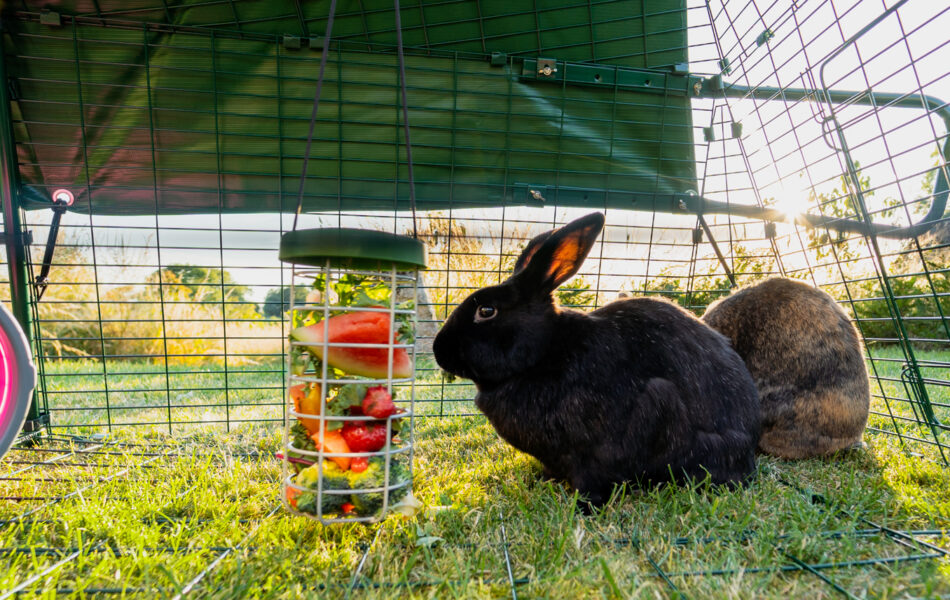

This entry was posted in Rabbits
Looking for some setup ideas for your small pet? With the beautiful weather and fresh air, your rabbits and guinea pigs are kicking their outdoor activities into high gear. Here’s how to maximise their space, offer plenty of enrichment, and keep them safe in their outdoor setup.
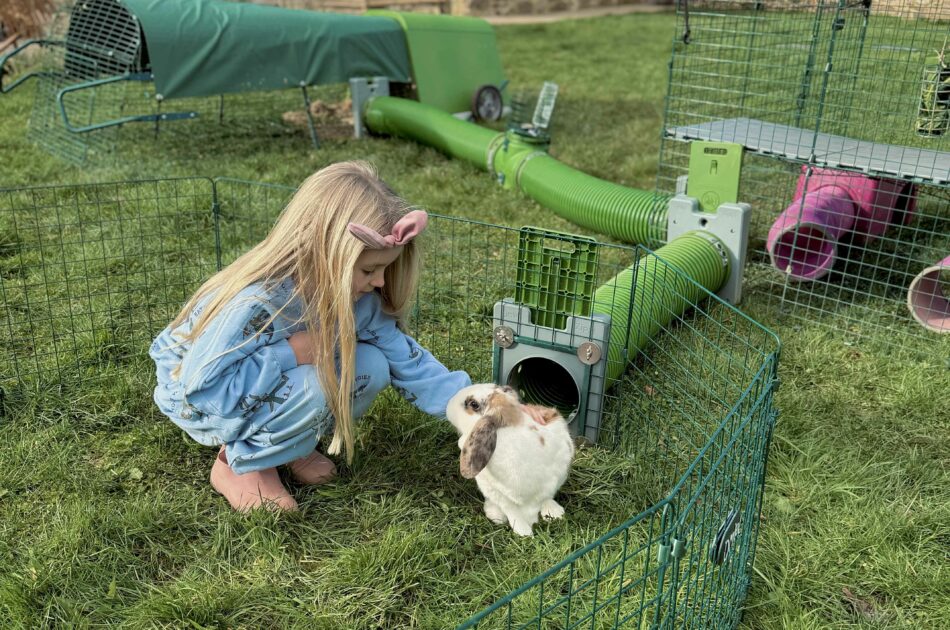
Small pet outdoor setups
Your rabbits’ or guinea pigs’ outdoor setup is more than just a space to play — it should offer them ample protection from the elements and predators. So before designing their inner sanctum, you’ll want to be sure that their enclosure is as safe as possible. To start your rabbit or guinea pig setup, make sure you have:
Once you’ve invested in these essentials, it’s time to create the perfect environment within.
Appeal to their nature
One of the best ways to ensure your rabbits’ and guinea pigs’ happiness is to appeal to their natural instincts and behaviors. For these small pets, activities like foraging and burrowing top the list. Thankfully, there are several ways to incorporate these activities in their outdoor space.
In the wild, rabbits excavate extensive tunnel systems. These tunnels provide shade and shelter while allowing them to exercise and explore. And while they may not dig their own, wild guinea pigs seek the shelter and safety of burrows created by other animals. This activity is a favorite of most rabbits and guinea pigs, and should be fostered whenever possible. Here are some ideas to create rabbit and guinea pig-friendly burrows in their setup:
- Create an above-ground burrow with a Zippi Rabbit and Guinea Pig Tunnel System that can be connected to any hutch or run.
- Cover a large-diameter PVC pipe with sod or top soil to create an earthy tunnel.
- Offer plenty of rabbit shelters or guinea pig hides throughout their enclosure.
- Partially bury large terracotta pots laid on their sides to create a cave-like shelter.
- Create a “dig box” for rabbits using a plastic container large enough for them to hop into, filled with hay, shredded paper, untreated sand, or other rabbit-safe substrates.
Foraging is also important for both species. Use a hanging rabbit and guinea pig treat holder to simulate this activity in their enclosure. Offer leafy greens, herbs, and other bunny and cavy-safe treats at a level that encourages them to stretch and scrounge for diverse vegetation.
Create more space
Like most pets, rabbits and guinea pigs thrive when they’re provided as much space as possible. This can be accomplished several ways, and it’s as beneficial for you as it is for your small pets:
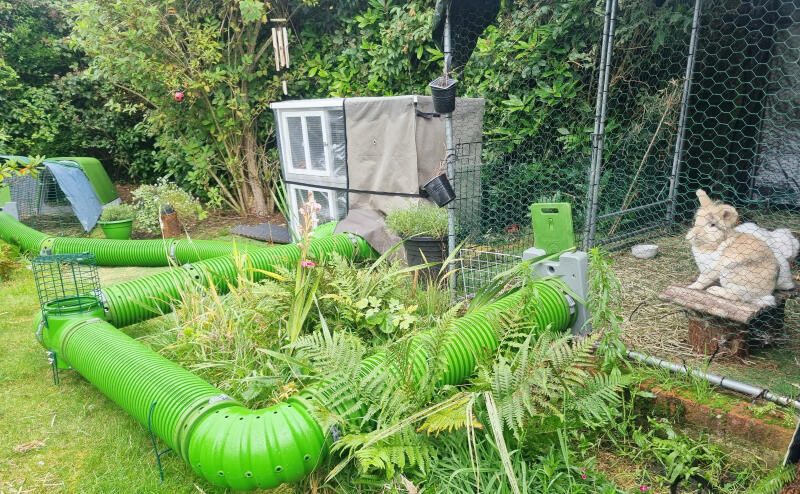
By connecting multiple runs and playpens together, you can change your pets’ experience between each of their areas. For example, one area can be dedicated to feeding, while another could hold enrichment items like toys, dig boxes, and treat holders. This further simulates the feel of a burrowing system that your pets would be utilising in their natural habitat.
DIY and complementing elements
DIY options for your rabbits’ and guinea pigs’ enclosure can be a fun project, and many are inexpensive. Some ideas include:
- Cardboard box mazes
- Paper towel or toilet paper tubes stuffed with Timothy hay
- Edible garland made from fresh veggies
And, with rabbit and guinea pig droppings being prime fertilizer for gardens, planting a garden near your rabbits’ or guinea pigs’ setup gives your plants quick access to nutritional excellence. You can also plant rabbit and guinea pig-safe plants and herbs in planters along the edges of your small pets’ run for them to nibble through the openings in the wire.
What to avoid in your small pets’ setup
Along with items safe for your bunnies’ and cavies’ setup, there are also elements to avoid. These include:
- Towels or other cloth materials that a toenail could easily snag on
- Plush toys (unless during supervised play)
- Electrical cords within reach of your pets
- Treated lumber
- Cedar wood or shavings
- Objects small enough for your rabbits or guinea pigs to choke on
This isn’t an exhaustive list, so if you’re unsure about what may or may not be safe for your pet, conduct thorough research through reputable sources. Breeders, national associations, rescues, and veterinary offices are all excellent resources to help you make safe choices for your small pet’s setup.
Omlet and your small pets
At Omlet, we believe that pet ownership should be about mutual fun, love, and companionship. That’s why we created safe rabbit and guinea pig hutches that are easy to clean and will keep your pets comfortable all year round. Combined with our line of Zippi Rabbit and Guinea Pig playpens, Zippi Rabbit and Guinea Pig Tunnel System, and Zippi Rabbit and Guinea Pig Platforms, your bunnies and cavies will have a small pet setup that will entertain and support them in every season.
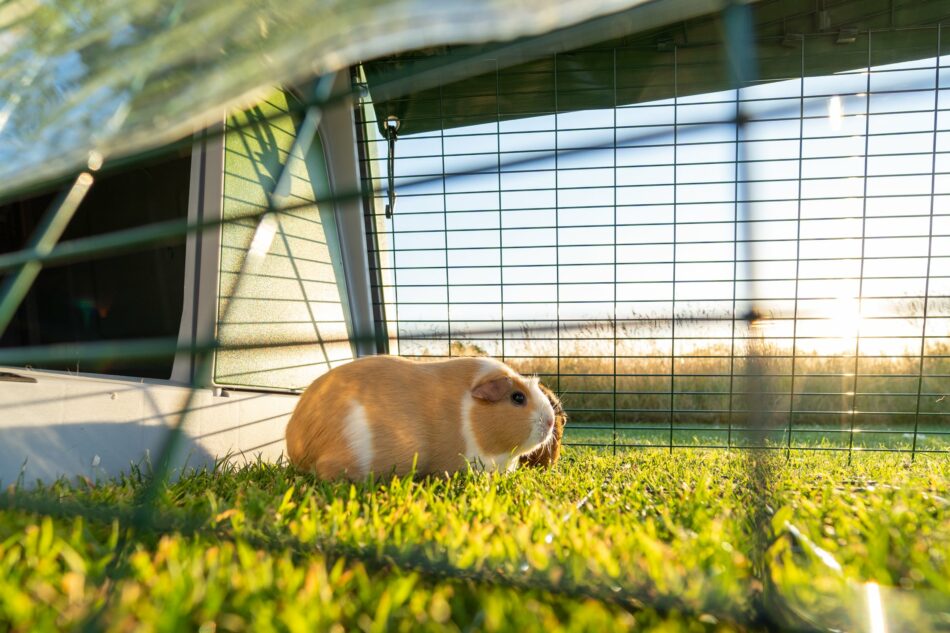

This entry was posted in Guinea Pigs
All the best things about having rabbits are worth celebrating. From their adorable appearances to their charismatic personalities, bunnies have long been favourite pets among families. Whether you’re just researching the joys of rabbit ownership, or are rediscovering your rabbits’ quirks, see why so many owners find bunnies to be the best pets.
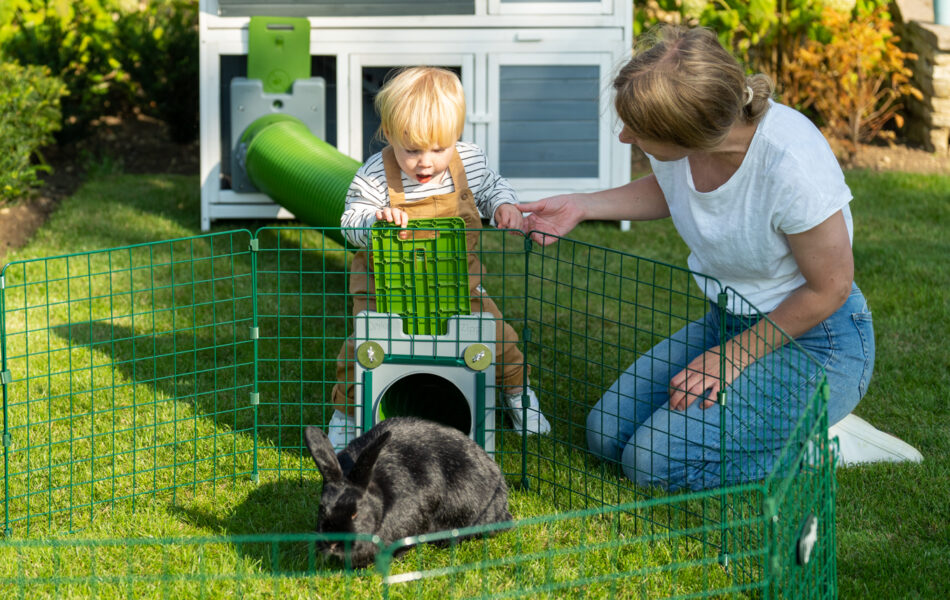
Adorable appearance
Rabbits are a classic inspiration for children’s books and toys, a mascot for springtime, and subject of countless viral videos. And it’s no secret as to why: there are simply very few things cuter than a bunny. From their twitchy noses, to their cotton ball tails, rabbits can’t help but be adorable. And with so many different breeds of bunnies, there are variations to these traditional traits. Erect or floppy ears, long or short coats, and sizes ranging from dwarf to giant, rabbit owners can keep a diverse sampling of the expansive range of cuteness that bunnies offer.
Charismatic companions
Bunnies are bundles of character just waiting to burst forth. From bunny “binkies” and “zoomies”, to soft nibbles and sprawling out on the ground, the body language of rabbits is both endearing and entertaining. And with so much energy, most bunnies are eager to play with their owners. Playing games with your rabbits is a great way to encourage them to stay curious and active, while strengthening the bond between you and your bunnies.
Alleviate allergies
People who are allergic to dogs or cats may find that they don’t react to rabbits. While they aren’t hypoallergenic, rabbits shed less fur and dander than larger pets. Since they can be housed outside, rabbits are less likely to trigger allergy symptoms in individuals. And, with an easy to clean rabbit hutch, you can greatly mitigate the potential for allergies among sensitive family members.
Space savers
Rabbits don’t require the amount of space that dogs or even cats do. Like other animals, providing the most possible space is always best for bunnies, but outdoor rabbit hutches can provide plenty of room without taking up much of your yard. Connect rabbit playpens to their hutch with Zippi Rabbit Tunnels to add space as needed, and watch your rabbits dive into their very own network of burrows and tunnels.
Fresh fertilizer
Did you know that avid gardeners buy rabbit droppings for their soil? Often referred to as “bunny gold”, your rabbits’ small poop pebbles make for amazing fertilizer. It’s a “cold manure”, meaning it can be added to plants and topsoil without being composted first. Use your rabbit’s droppings tray to freshen up your own plants, and gift (or sell) it to others for instant plant fuel.
Healthy habits
With all of that fresh produce comes the possibility of a healthier lifestyle — for you and your rabbits. Even if you don’t have a garden, your rabbits can serve as inspiration for a healthier lifestyle. Bunnies happily feast on fresh fruits and vegetables, so keeping your fridge stocked with produce can encourage healthier eating habits for humans and rabbits. Whip up a fresh salad for you and your bunnies to share, and you may find yourself fighting the sudden urge to binky, or jump, for joy with your newfound energy.
Long lifespans
Rabbits have much longer lifespans than other small pets like hamsters or guinea pigs. In fact, pet rabbits can live up to 12 years or more when cared for properly. This longer lifespan creates long, lasting bonds between bunnies and their owners. Taking your rabbit to the veterinarian regularly and performing rabbit health checks at home will ensure that your bunnies are aging gracefully, and that all of their needs are being met.
Soften stress
Did you know that a group of rabbits is called a “fluffle”? While the more technical term is a “colony”, the term fluffle seems to more accurately capture the true essence of rabbits. And with this beloved bunny fluff comes some potent stress relief. Studies have shown that petting a rabbit for 10 minutes can significantly reduce levels of the stress hormone, cortisol. Similarly, just watching a bunny bounce about in their environment can reduce stress significantly. So the next time you feel flustered, pay your fluffle a visit — and reap even more benefits by snuggling or petting your rabbits.
Omlet and your rabbits
There are so many great things about having rabbits. From their personalities to their appearance, rabbits make wonderful pets for families. Keep your bunnies binky-ing for years to come with spacious outdoor rabbit hutches and rabbit playpens, and appeal to their wild side with Zippi Rabbit Tunnels. With Omlet, your rabbits’ home is safe, supportive, easy to clean, and can be enjoyed by the whole family. So what’s the best thing about having rabbits? We believe it’s the companionship they provide, made possible through the care and attention of loving owners — just like you.
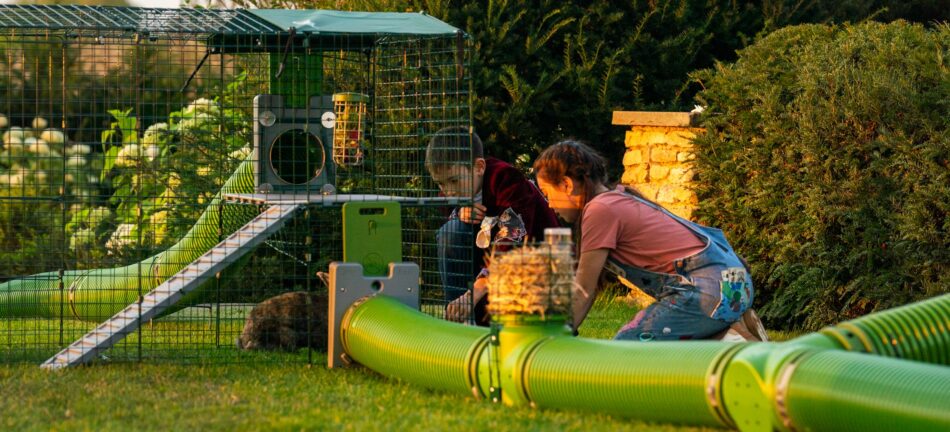

This entry was posted in Rabbits
Keeping your rabbit or guinea pig cool in the hot weather is something that all small pet owners have on their minds this time of the year. Summer is a wonderful time to spend with your rabbits and guinea pigs, but the rising temperatures can cause stress — for you and your pets. Here are some tips and tricks to keep your rabbits and guinea pigs cool when temperatures soar.
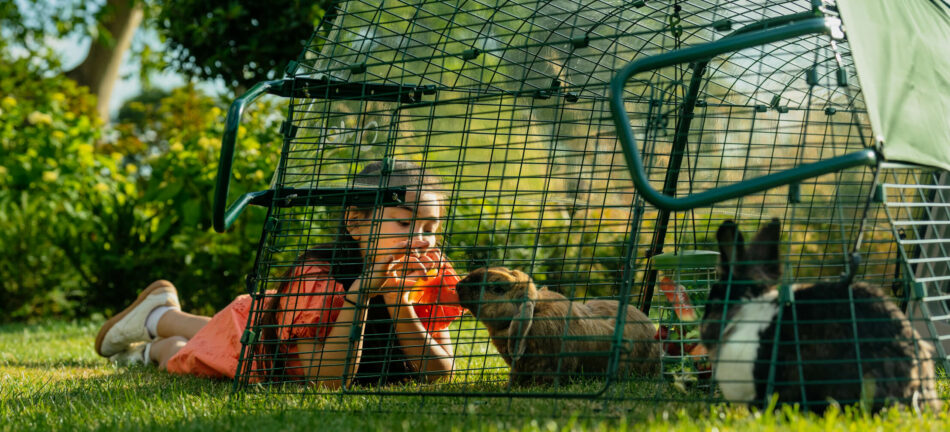
How hot is too hot?
First, it’s important to know when the temperature is simply too dangerous for your rabbits and guinea pigs to be outdoors. The answer of how hot is too hot is subjective to several factors, like:
- Your rabbit or guinea pig’s age and breed
- The ambient temperature vs “real feel” temperature (factoring in humidity)
- The amount of shade available
- How long the temperature will be elevated
As a general rule, you should watch for signs of discomfort from the heat in your rabbits and guinea pigs in temperatures above 85°F. Signs of heat stress in rabbits and guinea pigs include:
- Rapid or shallow breathing
- Open mouth breathing (panting)
- Drooling
- Lethargy
If left untreated, heat stress can quickly progress into heatstroke. Once your rabbit or guinea pig experiences heatstroke, there may be irreparable damage to their internal organs. Signs of heatstroke include those of heat stress, in addition to loss of consciousness or convulsions. If you think your rabbit or guinea pig is suffering from heatstroke, call your veterinarian right away.
How to keep your rabbits and guinea pigs cool
Thankfully, there are several ways to help keep your rabbits and guinea pigs cool in the summertime heat. These rabbit and guinea pig summer safety measures will help protect your pets from the heat, and allow them to spend more time outdoors.
An insulated hutch
Insulated rabbit and guinea pig hutches are the first line of defence against the heat. The Eglu Go Rabbit and Guinea Pig Hutch is twin-wall insulated with vents to provide airflow — which helps keep the hutch cooler than the ambient temperature. Choose a shady spot for your pets’ hutch to help it stay even cooler. When the temperatures really climb, add frozen water bottles inside of the hutch. Your pets will lay on them to cool off, and it will help to bring the interior temperature down even further.
Provide plenty of shade
Your rabbits and guinea pigs’ run should be shady to keep harmful UV rays and blistering heat off of your pets. Solid outdoor run covers keep the sun out, so that your rabbits and guinea pigs can cool down. Place water in the shaded areas to prevent algae growth, and to keep the temperature cooler. And, as with the hutch, add frozen water bottles around your pets’ shaded run to provide extra cooling relief.
Offer cooling hors d’oeuvres
Preparing frozen treats for your rabbits and guinea pigs can go a long way in keeping them cool. Here are some ideas for rabbit and guinea pig-friendly frozen treats:
- Fruit like bananas or strawberries
- Vegetables like green beans, corn, spinach, or broccoli
- Homemade frozen moulds or popsicles (with an applewood chew for a stick, or no stick) made from blended fruits and veggies
Add the frozen treats to a Caddi Rabbit and Guinea Pig Treat Holder to keep them fresh for longer, and hang it in a shady part of their run. You can also add ice cubes to your rabbits and guinea pigs’ water bottle to keep it at a palatable temperature.
There are refreshing treats that will help your rabbits and guinea pigs stay cool. These aren’t frozen, but they’ll help hydrate your pet, and when kept in the fridge, still provide a cooling effect.
- Apple slices
- Berries
- Lettuces
- Watermelon
Other heat-hampering techniques
There are a few other supplemental methods you can use to help beat the heat. Some of these include:
- Use a patio misting system around the top perimeter of your rabbits or guinea pigs’ run. Turn it on, or have an irrigation timer set for it to be on during the hottest part of the day.
- Install a large fan just outside of the run, or in the top corner of a rabbit or guinea pig walk in run. Make sure that your pets can’t reach any power cords or moving parts of the fan.
Use a combination of both of these for the strongest effect.
What to do when it’s too hot
Depending on where you live, your rabbit or guinea pig’s age and breed, and overall health condition, there may be times where staying outside is just too dangerous. These conditions are most likely to occur during a heatwave, or in areas that experience high humidity alongside soaring summer temperatures.
If you need to move your rabbit or guinea pig to cooler temperatures, try to keep them outdoors if possible. A well-ventilated garage, barn, or shed may be enough to keep their setup at a more comfortable temperature.
When shadier or cooler options just aren’t possible, you will need to bring your rabbits or guinea pigs inside. This shouldn’t be done lightly, as rabbits and guinea pigs that live outdoors year-round are accustomed to being in fluctuating temperatures. Bringing them into a stable environment will acclimate them to this type of temperature and they will need to remain indoors until the outside temperature is consistently lower.
It’s common for guinea pigs to be housed indoors, and placed outside for playtime. For these pets, outside visits should be limited to early morning and late evening hours during the summer to avoid the hottest part of the day. This is also true for rabbits housed indoors.
Omlet and your small pets
Summer isn’t without its challenges, but that doesn’t mean you shouldn’t be able to enjoy it with your pets. With our rabbit and guinea pig hutches, large outdoor rabbit and guinea pig runs, and outdoor run covers, you can provide plenty of shaded support for your pets throughout the summer. With an Omlet rabbit or guinea pig setup, you can enjoy a frozen treat together with your rabbits or guinea pigs, and rest easy knowing they’re being supported all summer long.


This entry was posted in Guinea Pigs
Understanding rabbit and guinea pig behaviour sets the foundation for a lifelong relationship with your pets. And when you take cues from your bunnies and cavies, you’ll know how to help them live long, healthy, and fulfilled lives. Here’s everything you need to successfully keep rabbits and guinea pigs, and how these elements help foster their natural behaviours.

Rabbit and guinea pig basics
Keeping rabbits and guinea pigs should be enjoyable, so choosing products that speak to their natural behaviours while being easy on your workload are a win-win. Here’s everything you need to foster a relationship with either rabbits or guinea pigs.
A safe hutch and run
As prey animals, rabbits and guinea pigs need to feel safe in their home. Both species need quiet, insulated, enclosed hutches to get a reprieve from the stimulating outside world and to keep them safe from predators and the elements. Providing a safe Rabbit and Guinea Pig Hutch is vital for their happiness and health. But what constitutes safety? A safe rabbit and guinea pig hutch will effectively protect your pets from all threats, from the weather to predators like hawks and raccoons. This refuge will be where your rabbits go to retire for the day, and what your guinea pigs will gravitate toward.
Quality food and fresh water
Both bunnies and cavies have teeth that continuously grow, and their diet helps them keep them in check. Quality pellets made from Timothy hay, and fresh Timothy hay offered free-choice will help keep their teeth filed down, as well as help their digestive tract move smoothly.
Guinea pigs also need vitamin C fortified feed, as they cannot manufacture their own. Bunny and cavy-safe treats like lettuce or other fresh fruits and vegetables can be offered in a Caddi Rabbit and Guinea Pig Treat Holder to supplement their diet in a nutritious and engaging way.
Bedding
Soft bedding should be provided to rabbits and guinea pigs to rest and nest in. Think of your bun or cavy’s bedding as a mattress topper and duvet for you — something soft to sink into at the end of the day. In the warmer months, pine shavings or pellets are a nice choice, as they don’t trap much heat. During the winter, opt for a thick layer of straw to help bolster their hutch insulation. Recycled paper pulp bedding also offers comfort year-round. Bedding also absorbs moisture and odours, helping to keep your pets’ hutch and their coats clean and fresh.
Bonus elements
With the essentials on hand, you’ll provide your rabbits and guinea pigs with what they need in order to be healthy and happy in their home. But there are some additional elements to add to elevate ordinary life to an extraordinary level. These accessories might not be essential to the health of your bunnies and cavies, but they will do wonders for their minds and bodies — and for your own enjoyment.
Above-ground burrows
In the wild, rabbits build extensive tunnels, known as burrows, to form a large network called a warren. Multiple rabbits share a warren, and use the connected burrows to relay messages, access the above-ground world, as well as for sleeping, eating, and shelter during times of danger or weather events. And while they may not dig their own, wild guinea pigs will find abandoned burrows or dens dug by other animals for the same purposes.
Investing in some Zippi Rabbit and Guinea Pig Tunnels simulates this type of burrowing network, and makes it easy for you to create new routes and pathways to explore. Having these above-ground burrows channels their natural instinct and provides a sense of safety and shelter, whilst making their home more exciting.
Platforms for prime viewing
Being animals of prey, rabbits and guinea pigs often seek a higher vantage point to get a better view of the world around them. Rabbit and Guinea Pig Platforms give your pets this space to get a glimpse of their surroundings, while also offering a shaded space below. The ramp exercises their leg and back muscles, and the elevated surface helps you interact with your pets on a whole new level.
Spacious playpens for epic play sessions
Rabbit and Guinea Pig Playpens are the perfect space to hangout with your pets, or for conducting training sessions, grooming, or playtime. Connect multiple playpens together to create the ultimate warren, or opt for a fully-enclosed Walk In Rabbit and Guinea Pig Run for all-around safety and comfort. The more space you can provide your bunnies and guinea pigs with, the better it is for their minds and bodies.
Other considerations
While these might not be tangible goods, there are some other angles to consider when keeping rabbits or guinea pigs. These provisions will ensure that your bunnies or cavies are being supported in aspects beyond their housing and enrichment. They include:
- Veterinary care for if your rabbit or guinea pig experiences illness or injury. Be sure to research veterinarians that treat rabbits and guinea pigs specifically, as they aren’t part of every small animal veterinarian’s realm of expertise. A veterinarian can also spay or neuter your rabbits or guinea pigs if needed.
- Choose a pet sitter for when you need to go out of town. Bunnies and cavies should be fed daily, so someone will need to care for them while you’re away. Keep an updated list of care instructions to provide, and invite your designated pet sitter over to introduce them to your pets ahead of time.
- Set expectations for you and your pets. Part of understanding rabbit and guinea pig behaviour is observing them and recognizing when they’re being pushed out of the comfort zone. Always make sure to interact in a place and at a pace that your pets are comfortable with, being sure to make each interaction as positive as possible.
With these things in mind, along with a supportive setup, your bunnies and cavies will be equipped to share a lifetime of experiences with you.
Omlet and your rabbits and guinea pigs
All over the world, pet parents of rabbits and guinea pigs choose Omlet to house and provide for their furry family members. From ultra-strong and supportive Rabbit and Guinea Pig Hutches and secure Rabbit and Guinea Pig Playpens, to unique Zippi Rabbit and Guinea Pig Tunnels and Rabbit and Guinea Pig Platforms, you’ll appeal to your bunnies’ and cavies’ natural behaviours and foster the bond forged between pet and owner with our ingenious pet products.
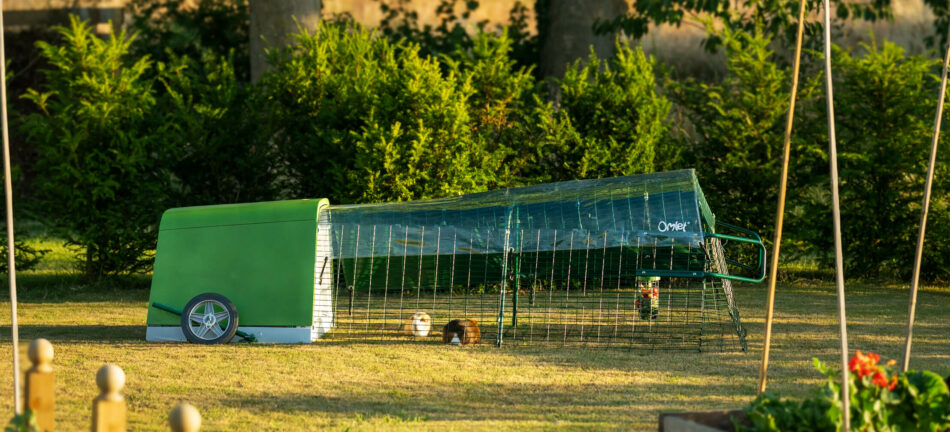

This entry was posted in Guinea Pigs
Thinking about adding small pets to your family, but caught up on the myths about keeping rabbits and guinea pigs? There are some common misconceptions about these pets that can sway new owners’ opinions of them. But we’re here to set the record straight and highlight the amazing attributes that these animals have to offer.
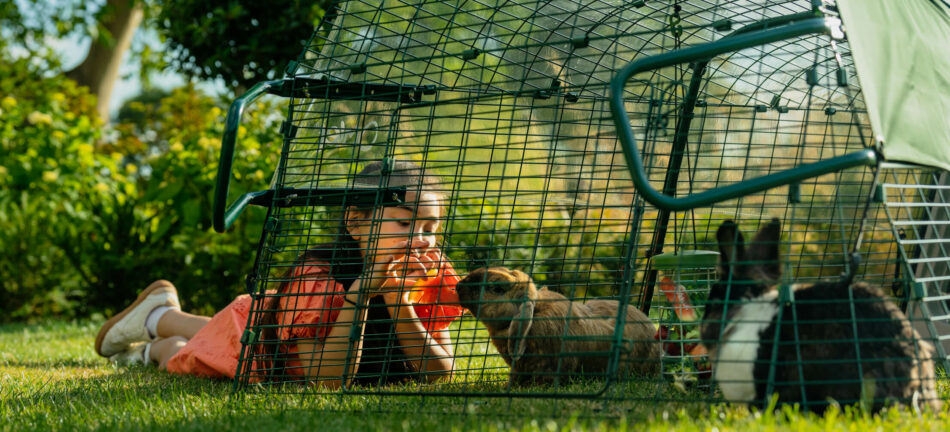
Rabbits
Rabbits make wonderful pets for owners of various ages and experience. They’re affectionate, intelligent, and are a joy to watch and interact with. But like all pets, bunnies have characteristics and preferences particular to their species that dictates their care, which has led to several myths surrounding them. Here are some of the most common myths about pet rabbits.
Myth: rabbits are low-maintenance pets for children
Fact: rabbits require daily care and careful interaction
Rabbits aren’t ideal for young children due to their care requirements and the skills needed to handle them safely. Their food and water should be refreshed daily, and they benefit from fresh greens and other rabbit-safe treats a few times a week. Bunnies also need their bedding changed regularly, otherwise they can suffer from flystrike — a serious condition that can result in death. Rabbits also need routine veterinary visits to have their teeth and nails trimmed if needed, and for general health checkups.
Their strong hind legs and sharp toenails make handling rabbits difficult for younger children. And, if startled or handled too roughly, rabbits can bite with their long front teeth. Because of these factors, rabbits should be primarily cared for by an older child or adult.
Myth: rabbits can live alone
Fact: rabbits need the companionship of other rabbits
Many people keep rabbits as solitary animals, but bunnies are very social animals that thrive in pairs or groups. In the wild, rabbits live in large family groups called colonies, and spend their days together. As pets, a pair of rabbits will groom each other, sleep together, and play throughout the day. Same-sex pairs are most successful with females or neutered males, or a spayed female and neutered male.
A singular rabbit can become depressed and listless, or even display negative behaviours like thumping, teeth grinding, or growling. To make sure bunnies live their lives to the fullest, it’s best to adopt them in pairs, or slowly introduce new rabbits together to form a bond. Once bonded, rabbits will live peacefully together for the duration of their lifespan.
Myth: rabbits love to be held and cuddled
Fact: most rabbits are nervous being held
As prey animals, rabbits are easily stressed being picked up and held. The act of lifting your rabbit simulates being snatched by a predator in the wild, and these instincts run deep. As a result, the majority of pet rabbits are not comfortable being held.
This doesn’t mean that you can’t interact or even snuggle with your bunny — you just have to let it be on their terms. Sitting with your rabbit and encouraging them to hop into your lap, or having them hop onto an elevated surface like a rabbit platform before picking them up will reduce the height from which they’re being lifted, making them feel less vulnerable. Slowly acclimating your rabbits to being held or picked up will help them gain confidence.

Guinea Pigs
Guinea pigs are loveable pets with big personalities. They’re adorable, vocal, and fairly easy going, making them ideal pets for owners of all ages — so long as an adult is the primary cavy caregiver. But their appearance and vocalizations have led to some common misconceptions. Here are popular myths about cavies, and what prompted such beliefs.
Myth: guinea pigs don’t need much space
Fact: cavies must live in pairs, and need plenty of space
Don’t let their compact size fool you — guinea pigs need plenty of space. They also need to be kept in pairs, as they form strong social bonds between each other. Always aim to provide as much space as possible with guinea pig runs and playpens.
Guinea pig hutches should be large enough to accommodate two cavies comfortably, and have an attached exercise area. Not only will cooped up cavies become bored, but guinea pigs are prone to being overweight, so exercise is essential. Plus, if you give your guinea pigs enough room, they’ll likely reward you with their trademark “popcorning” move.
Myth: guinea pigs are related to pigs
Fact: they are members of the rodent family
The exact origin of the name “guinea pig” isn’t clear, as they are neither from New Guinea, nor are they pigs. They originated from Peru, and are members of the rodent family. There are various theories as to how they got the first part of their name — from British currency to the trade ship route taken when importing them to other countries. The “pig” portion of their name comes from the vocalisations they make. Guinea pigs are also called “cavies” because the Latin name for them is Cavia porcellus, or “cavy” for short.
As members of the rodent family, they share some similarities with their distant cousins, mice, rats, and even capybaras, the world’s largest rodents. Guinea pigs have incisors (front teeth) that grow continuously throughout their lives, and round eyes on the sides of their head. They lack a noticeable tail, making them appear more like large hamsters or tiny capybaras.
Myth: guinea pigs have short lifespans
Fact: they can live up to 8 years with proper care
Rodents generally have short lifespans, but guinea pigs have life expectancies similar to those of rabbits — usually around 6-8 years. In contrast to domesticated guinea pigs, wild cavies, or “cuy” as they’re called in Peru, only have a life expectancy of 1-4 years. But in order to live a long, full life, guinea pigs need the right nutrition.
Guinea pigs can’t manufacture their own vitamin C, so it must be supplemented in their diet. Most commercial guinea pig feed is fortified with vitamin C, but you can supplement their intake with fresh foods like bell pepper or strawberry tops, or with fortified guinea pig treats. Be sure to treat your piggies sparingly, as they can become obese easily.
A myth about rabbits and guinea pigs
Myth: rabbits and guinea pigs can be kept together
Fact: this is true — to an extent
Rabbits and guinea pigs can be kept together, but only with experienced owners and under certain conditions. To keep rabbits and guinea pigs together, the following adjustments and practices must be adhered to:
- Guinea pigs need vitamin C in their diet, while rabbits can produce their own and may become ill if they live on a guinea pig diet. Rabbits also eat more and faster than guinea pigs, meaning cavies might miss out on meals. Always feed rabbits and guinea pigs separately.
- Rabbits and guinea pigs don’t speak the same language, so recognizing the body language of each is crucial to know when one species is stressed or is feeling threatened.
- All animals kept together should be spayed and neutered, but this is especially important when keeping different species together. Intact male rabbits especially can cause serious harm to guinea pigs trying to dominate or mount them.
Keeping these two species together is possible, if you have adequate space and separate feeding areas for each. Pay special attention to their personalities and assess whether separation is needed at any point in time.
Omlet and your rabbits and guinea pigs
No matter which species you keep, our rabbit and guinea pig hutches have been designed to support the needs and preferences of both bunnies and cavies. With customizable rabbit and guinea pig tunnels and outdoor pet runs, you can simulate their natural environment to help them get in touch with their innate behaviours. When you appeal to their wild side, you’ll be rewarded with healthy, happy rabbits and guinea pigs that will never cease to amaze and inspire you.
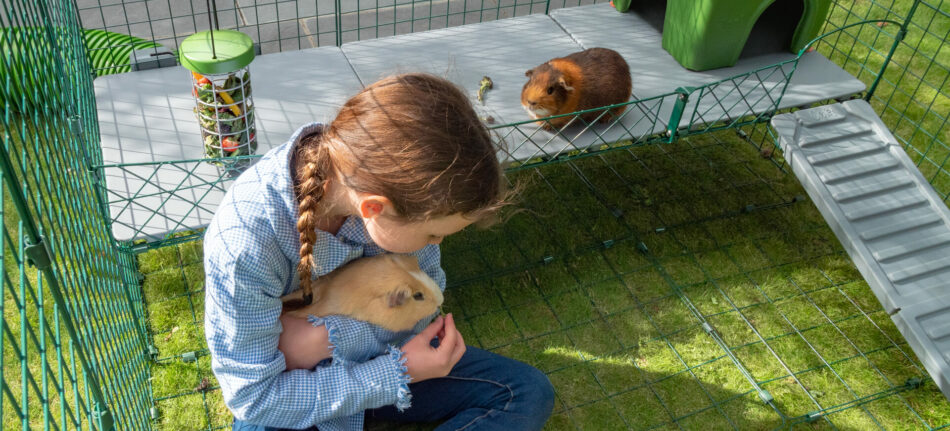

This entry was posted in Guinea Pigs
Looking for some inspiration for playtime with your small pets? There are several games you can play with your rabbits and guinea pigs that will be to the delight of everyone involved. From mazes to hide-and-seek, here are some pastimes that are sure to please your pets the next time you play.
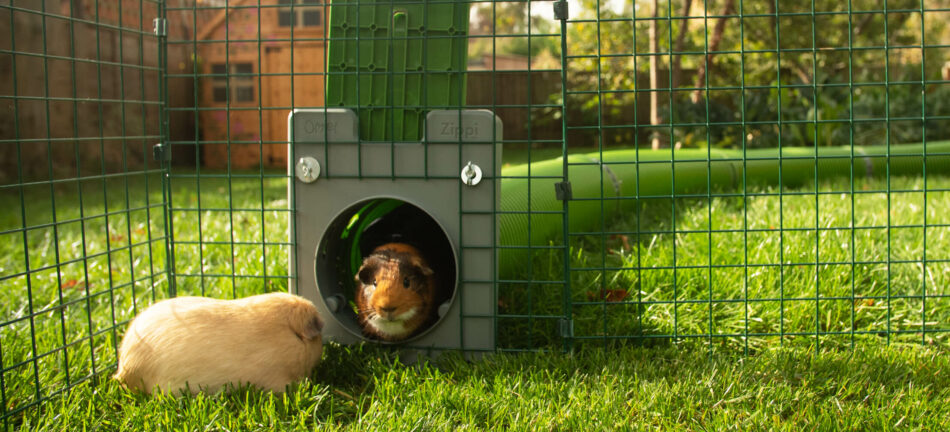
The importance of play
Playing with your rabbits and guinea pigs builds their trust and confidence, which in turn helps you build a more meaningful and lasting bond with them. It’s amazing to see shy or timid pets come out of their metaphorical shells through playing with their humans. Being more active is good for their minds and bodies, and is one of the best ways to encourage your small pet to be more outgoing and physically fit. Through dedicated playtime, you’ll be able to forge an unbreakable bond between you and your rabbits or guinea pigs.
It’s also important to remember that rabbits and guinea pigs are prey animals by nature, so surprises, sudden movements, or loud noises can startle them easily. All of the games that you play with your small pets should be in a calm atmosphere, and with lots of treats to offer as tokens of encouragement and as rewards for their efforts.
Species-specific
Rabbits and guinea pigs differ in size and stature, so they each have their own set of skills that can be tapped into during play. For example, rabbits have long, powerful legs, so jumping over the sides of a homemade maze to fast-forward to the treat at the end is entirely within their realm of possibility. For the following activities, we will offer suggestions to modify each game based on the size and species of your pet.
Prepare a place to play
The best place to play with your rabbits and guinea pigs is in a safe and enclosed space. Outdoor rabbit and guinea pig runs are perfect for spending time with your pets during playtime. The enclosed space will keep them contained and comfortable, and gives you plenty of space to set up your games. Alternative play places are safe spaces inside your home — just make sure that the room you’re playing with your pets in is rabbit and guinea pig-proof.
Bowling
This game is more fitting for bunnies, but some guinea pigs may delight in barrelling objects over. Set up small bowling pins, like indoor sets designed for toddlers, and let your bunnies nose-boop them over. Reward your pets’ efforts with a treat before setting the pins back up for the next round.
Guinea pig modification: in relation to guinea pigs, even toy bowling pins may seem tall and intimidating — try setting up empty toilet paper tubes instead.
Magic cups
Show your rabbits or guinea pigs that you’re hiding a treat under an overturned plastic cup. Add one or two more overturned cups with nothing under them, then slide them around before allowing your pet to sniff out the hidden treat. Fresh herbs or other fragrant treats are perfect for this game.
Fetch
Think fetch is just for dogs? Think again — some rabbits and guinea pigs enjoy carrying small objects in their mouths. Try tossing small toys like balls, applewood chews, or pieces of cardboard for this game. To start out, toss the object just a few inches in front of your rabbit or guinea pig. If they pick it up, praise them, and offer a treat. Once they’re consistently picking up their toy, toss it farther out each time, and encourage them to bring it back to you.
Hide and seek
Rabbits and guinea pigs are curious by nature, so enticing them with some mystery will pique their interest. Lay on the floor and place your face in your hands. Your rabbit or guinea pig will come to investigate. Be careful not to startle your pet as you emerge, and be sure to offer them a treat for their cleverness.
Rabbit modification: hide under a soft blanket and call your rabbit. Bunnies love to burrow, so your rabbit will be thrilled at the prospect of digging in order to find you.
Maze running
Create mazes from cardboard boxes, building blocks, or other household objects with a treat placed at the end. Make sure that mazes are always placed at ground level, and that there are no small gaps or spaces for your pets’ feet to get caught in.
Rabbit modification: construct a maze from Zippi Rabbit Tunnels for the ultimate, reusable maze that your rabbits won’t hop out of.
Omlet and your rabbits and guinea pigs
From the rabbit or guinea pig hutch to outdoor runs and playpens, we’ve worked to create the perfect atmosphere for owners to spend quality time with their small pets. Design your own playground with Zippi Rabbit and Guinea Pig Tunnels, and add rabbit and guinea pig platforms to help your pets meet you on a whole new level. With Omlet, playtime isn’t just possible — it’s the pinnacle of quality time spent with your rabbits and guinea pigs.
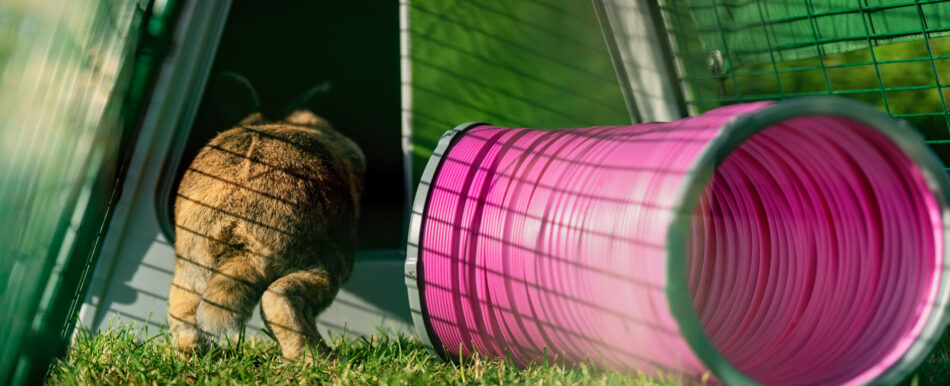

This entry was posted in Guinea Pigs
Exercise for rabbits and guinea pigs is important for their overall well-being, but it’s also a unique opportunity for you to bond and play with them. From playtime to training sessions, there are several ways to spend quality time with your rabbits and guinea pigs while benefiting their physical and mental health. Discover how much exercise your pets need, how to keep them fit, and how to build a bond through boredom busting activities with your rabbits and cavies.
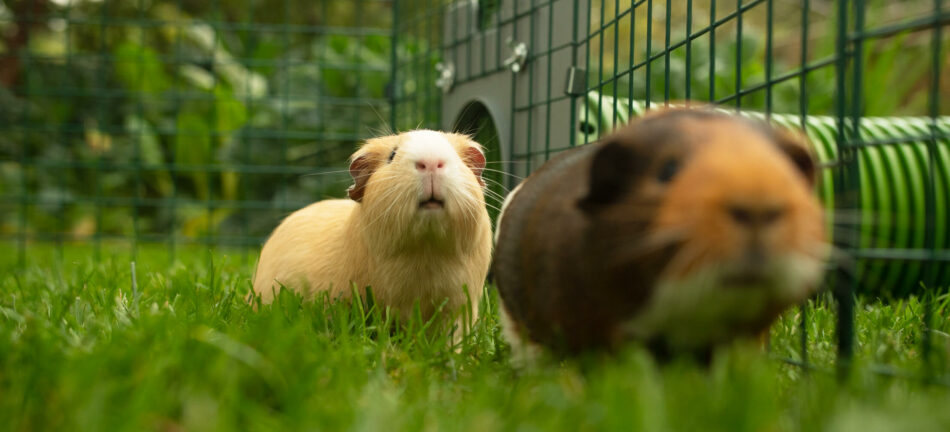
How much exercise do rabbits and guinea pigs need?
Rabbits and guinea pigs need to be able to exercise on their own, as well as doing activities with their owners. The amount of exercise needed for each pet varies and is dependent upon their genetics, diet, and environment. This means that these pets need spacious outdoor rabbit runs or guinea pig playpens to ensure they have ample space to run, hop, stretch, and explore.
Wild rabbits and guinea pigs are constantly on the move for their survival. This continuous need to move keeps them fit and spry — which are traits not always seen in their domesticated counterparts. While our backyard rabbits and guinea pigs may be distantly related to their ever-moving ancestors, their body compositions are still very similar. All rabbits have long, powerful hind legs, and guinea pigs are all potato-shaped with short legs and necks.
Guinea pigs are especially prone to being overweight, which puts strain on their small legs and joints. But rabbits aren’t immune to issues caused by lack of exercise — they too can become overweight, and are also prone to boredom if they aren’t properly stimulated. Bored bunnies can become depressed or develop destructive habits. By giving bunnies and cavies plenty of outdoor space, you’ll help them get enough exercise to keep them healthy and happy.
Encouraging your rabbits and guinea pigs to exercise
Fostering your pets’ natural behaviours is one of the best ways to encourage them to exercise. Because of their anatomy and natural instincts, rabbits need large, outdoor spaces to fulfil their need to run, burrow, and scratch. Zippi Rabbit Tunnels simulate burrows in the wild that rabbits run through, which will encourage your bunnies to explore and play. And while guinea pigs might not dig their own tunnels in the wild, they will happily use burrows dug by other animals — or in the case of domesticated guinea pigs, those provided by humans.
Guinea pigs can’t stand on their hind legs like rabbits can, so they appreciate a higher vantage point from which to view their world. Zippi Guinea Pig Platforms offer your cavies an elevated place to explore, and a shady, secluded space to hide beneath. The attached ramps encourage your guinea pigs to carry their weight at an incline, which strengthens their muscles and helps them maintain their figure.
Exercises you can do with your rabbits and guinea pigs
There are several ways to interact with your rabbits or guinea pigs while encouraging them to exercise. Some ideas include:
These are all fun ways to keep your pets fit both physically and mentally, while also providing you with a unique opportunity to build trust and confidence with them. Aim to incorporate half an hour of playtime with your bunnies and cavies once a day to help keep your pets bodies and minds stimulated. Playing with them doesn’t have to be robust, so any amount of interaction or movement that they would otherwise not be experiencing will build both a confident mind and strong muscles.
Exercises to avoid with your rabbits and guinea pigs
There is some equipment marketed for rabbits and guinea pigs that should be avoided, and some activities they shouldn’t participate in. These include:
- Exercise wheels or balls (similar to those for hamsters) marketed for rabbits or guinea pigs
- Leashes and harnesses
- Walks around your neighbourhood
While it might be tempting to take your rabbits or guinea pigs for walks on a harness, the vast majority of small pets find harnesses uncomfortable and alarming, so it’s best to play with your bunnies and cavies within the safety of playpens designed for them, or in a pet-proof area of your home. Rabbits and guinea pigs are prey animals, and as such can startle and bolt easily with sudden sights and sounds — the strain from them spooking on a harness can cause severe damage to their necks, backs, and legs.
Omlet and your rabbits and guinea pigs
From guinea pig playpens and outdoor rabbit runs, we’ve created safe and smart enclosures that allow your pets the freedom to move and explore. These spacious options also make it possible for you to join them in their endeavours — putting you front and centre in their lives. Watch your rabbits and guinea pigs explore through Zippi Tunnels, climb and meet you face-to-face with Zippi Platforms, and witness them experiencing the joy of fresh grass with mobile rabbit and guinea pig hutches. You, your pet, and Omlet are a winning combination for years of health and happiness to come.
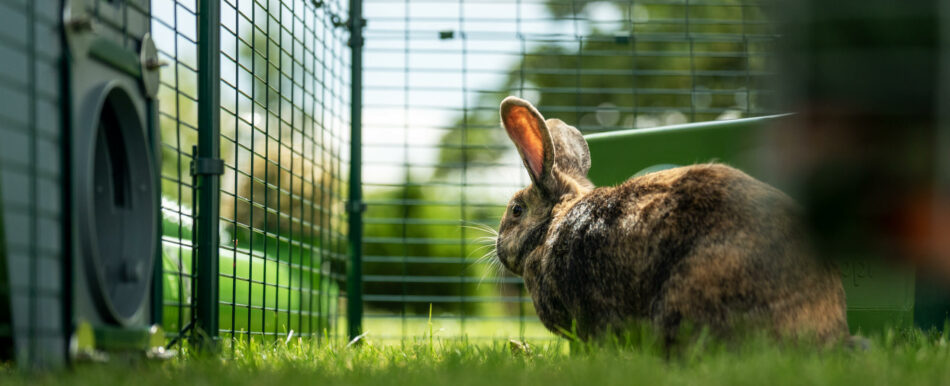

This entry was posted in Guinea Pigs
Spending time with your rabbits or guinea pigs is a great way to grow your bond with them, especially when there are toys involved. DIY toys for rabbits and guinea pigs are easy to make with materials that are probably already in your home. And these toys aren’t just for your pets — you’ll find that watching and interacting with your rabbits or guinea pigs through toys is both engaging and entertaining. Discover how making some of your rabbits and guinea pigs toys can be fun and rewarding.

Why do rabbits and guinea pigs need toys?
First, it’s important to understand why rabbits and guinea pigs need toys. Think back to your childhood — you likely played with toys as a means of entertainment, but also to aid in the development and growth of your cognitive skills. The same is true for rabbits and guinea pigs.
Rabbits and guinea pigs are able to keep themselves active and entertained with toys, as well as grow their critical thinking and problem solving skills. These pets may be small, but they’re smart and enjoy objects to chew, toss, chase, or cuddle up with. There are several types of toys for rabbits and guinea pigs that can be purchased, but there are many that you can make at home.
How to play with your rabbits and guinea pigs
Playtimes are some of the best times with your rabbits and guinea pigs. Owners that play with their pets get to experience their individual personalities, and build a bond with them that lasts a lifetime. Through play, your pets will learn to trust you, and you’ll be able to identify their unique body language and needs.
Start by sitting on the floor or the ground with your rabbits or guinea pigs. Offering treats will help entice them to approach you if they are not already comfortable doing so. Introduce new toys one at a time so your pets aren’t overwhelmed. Show them their toy, maybe offering some movement if your pet is comfortable with it. Hang or place the toy in front of your pet, and watch them explore this new offering.
Some rabbits and guinea pigs can be taught to fetch small toys, while some are more interested in the aspect of chasing. Play around with different ways of interacting with your pets, like with Zippi Rabbit and Guinea Pig platforms to help you both see eye-to-eye.
Types of DIY toys for rabbits and guinea pigs
The most common types of toys for rabbits and guinea pigs include:
- Chews
- Activity toys
- Tunnels
- Forage boxes
- Hideouts
You can make your own versions of many of these toys using household objects, or with a short trip to your local hardware store. It’s important to remember to choose non-toxic materials for your pets’ toys. Never use treated lumber or paint for your rabbits’ or guinea pigs’ toys, and make sure that any cardboard or fabric is removed if your pets begin to nibble on them. And, it’s always a good idea to supervise your pets while they’re playing with their toys — especially if they are inclined or able to eat them.
DIY rabbit and guinea pig chews
Most rabbit and guinea pig chews are made from apple wood or compressed timothy hay, or a combination of the two. There aren’t many substitutes for apple wood chews for rabbits and guinea pigs, as they are the safest variety. But, by purchasing bulk apple wood sticks and timothy hay, you can craft your own chew toys by wrapping the sticks in strands of hay. Cut them to various lengths, and create different shapes for variety. Sisal rope can also be used to wrap apple chews and hay together — just remember to remove the toy as soon as the rope becomes frayed or gnawed.
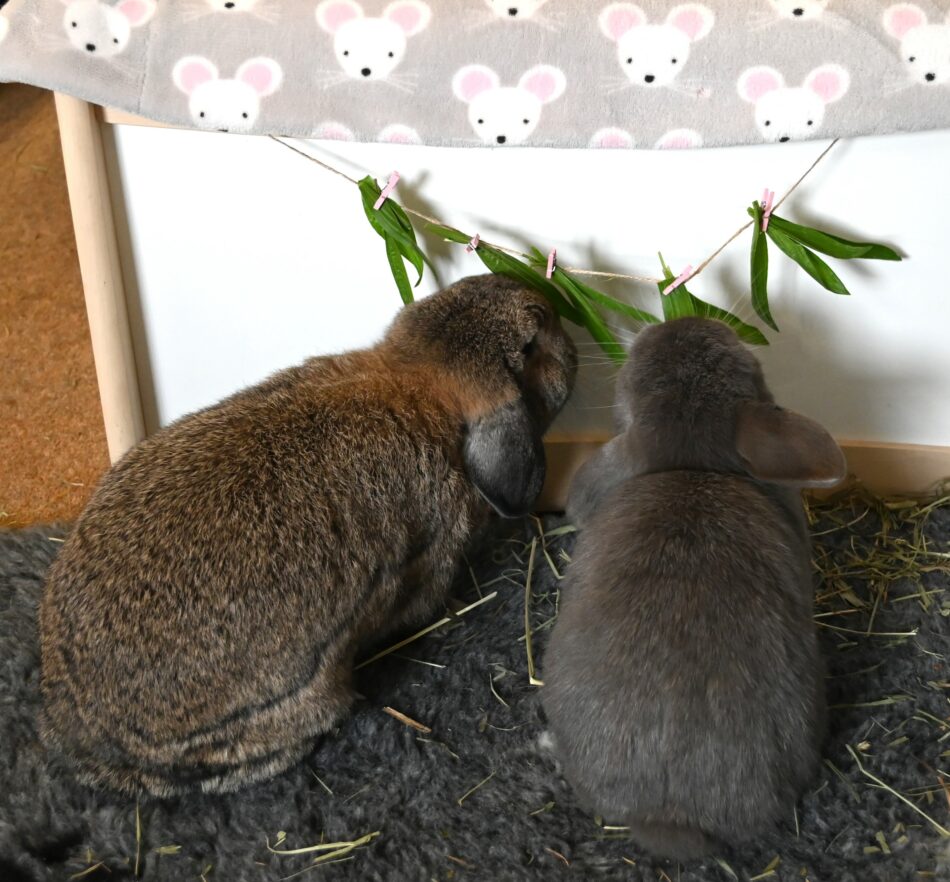
DIY rabbit and guinea pig activity toys
Activity toys are those that hang from your rabbit and guinea pig run. They’re designed to encourage your rabbits and guinea pigs to stretch, nudge, or tug. Most of these toys are made from apple wood and sisal rope, which are safe options for your pet. Experiment by making spiral or branch shapes, or by threading alternating pieces of apple wood with other edible treats like rabbit and guinea pig-safe fruit or veggies.
You can also hang a Caddi rabbit and guinea pig treat holder in their run to encourage the same activity. The Caddi reduces waste, and has lots of room for your pets’ favourite treats.
DIY rabbit and guinea pig tunnels
Rabbit and guinea pig play tunnels that are made for small pets will hold up better than DIY alternatives. Some owners make tunnels from drainage tubing, but the small holes designed to release water pose a risk to your pets’ feet. A Zippi Rabbit and Guinea Pig Tunnel System is the best investment when it comes to fostering natural burrowing behaviours in both pets. The safest way to create temporary tunnels for your rabbits and guinea pigs in the meantime is to use boxes connected end-to-end.
DIY rabbit and guinea pig forage boxes
A shallow storage tote or livestock feed bin makes an excellent base for a forage box for your rabbits and guinea pigs. Pour 1-2 inches of sand or top soil into the container, or add scraps of recycled cardboard or paper to create a substrate for your pets to dig through. Rabbits in particular will appreciate the opportunity to dig in soil. Once you’ve added a layer of substrate, toss small toys, chews or treats into the box and watch your pet forage for their findings.
DIY rabbit and guinea pig hideouts
There are several ways to create hideouts for your rabbits and guinea pigs. As prey animals, they both appreciate the opportunity to hide when they’re tired, overwhelmed, or during games of chase with each other. Rabbit and Guinea Pig Shelters are specially designed to create a safe haven for your small pets, and are the best option to be kept with their rabbit or guinea pig hutch and run. But, short play sessions, or additional options can be created with cardboard boxes, overturned plastic plant containers with an entrance cut into them, or with other creative alternatives. Just remember not to use treated materials, and be aware that DIY options are not weatherproof, and should not serve as a substitute for their hutch.
Omlet and your pets
From rabbit and guinea pig hutches, to outdoor rabbit and guinea pig runs , discover how your pets encounter their world when you’re able to take an active role in it. Explore with them, encourage them, and most of all, enjoy them on a daily basis when you have rabbit and guinea pig products that have been designed to bring you closer than ever.
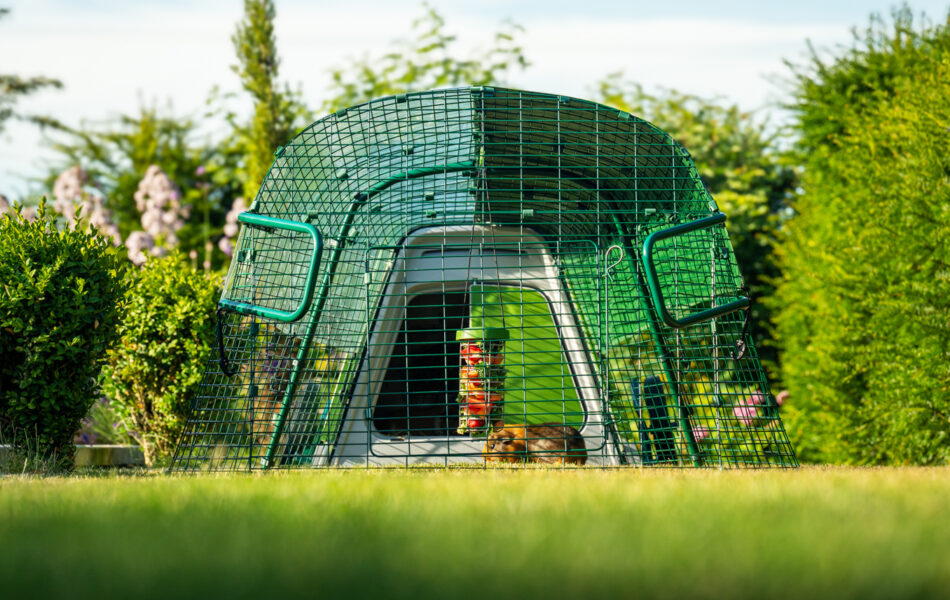

This entry was posted in Guinea Pigs
Thinking about adding a small pet to your family? Despite having different needs, rabbits and guinea pigs require many of the same accommodations, so whichever you’re considering adding to your family, your shopping list will look similar. From hutches and runs, to play and feed, we’ve got the ultimate rabbit and guinea pig checklist for you to tick off before you bring your fluffy new friends home.

Caring for rabbits and guinea pigs
Rabbits and guinea pigs both make wonderfully rewarding family pets. They can be housed indoors or outdoors in suitable climates; either way they need plenty of room to roam and certain equipment to stay safe, happy and healthy. With the appropriate setup and care, rabbits and guinea pigs can live up to 8-10 years.
Rabbits and guinea pigs have different nutritional needs and communication methods, so should be kept separately. They’re both social animals however, and need the companionship of their own kind. So, when planning your pets’ future home, make sure you can provide room and care for at least two of either.
Hutches
Traditionally, rabbit and guinea pig hutches have been made of wood, but this poses a few problems. Both rabbits and guinea pigs have teeth that grow continuously. They need to gnaw almost constantly in order to keep their incisors from over growing, which leads to serious health problems. Wooden hutches are tempting to chew on, and treated lumber can be toxic to pets. They’re also drafty, inadequate in more extreme weather, and absorb moisture, ammonia and odors, so can become unhygienic and need replacing in no time at all.
Eglu Go Rabbit Hutches and Eglu Go Guinea Pig Hutches are designed to give your small pets the safety and comfort they need and deserve. They are both also designed to be used in conjunction with fixed, steel mesh runs, giving your rabbits or guinea pigs free access to an outdoor space (more on this below.)
- Made of pet-safe, strong, durable plastic
- Twin insulated for optimal internal temperatures
- Draft-free ventilation
- Easy to clean in a matter of minutes
- Predator proof design
- Built to last a lifetime
Starting out with a durable, easy clean rabbit or guinea pig hutch is an investment you will soon recoup, which will set you and your pets up for success from the first day.
Bedding
The bedding you use inside of your rabbits’ or guinea pigs’ hutch should be natural and absorbent. Typical bedding options include:
- Pine shavings or pellets
- Aspen shavings
- Recycled paper (this resembles loose cotton)
- Straw
Breeds of rabbits with long hair like Lionheads or Angoras need recycled paper or pine pellets as bedding – straw and shavings will get tangled in their coats. Similarly, breeds of guinea pigs with long hair like Peruvians or Shelties should not be kept on shavings or straw bedding.
Outdoor space
Rabbits and guinea pigs need plenty of space outside their hutch to stretch their legs and explore, which they should ideally have constant, secure access to. Rabbits in particular have lots of energy, so a spacious outdoor rabbit run is essential to helping them stay healthy and happy.
If you’re short on outdoor space, the Omlet Zippi Tunnel System is a great way to recreate their natural environment and let them zoom when the mood takes them, as it lets you connect their hutch to additional enclosures in different areas, as a burrow would. Guinea pigs also need an outdoor guinea pig run to stay fit and can also benefit from a tunnel system, as they can be prone to obesity and boredom if they don’t have enough space to exercise.
Omlet’s rabbit and guinea pig runs have attached floor panels to prevent digging out, which is an issue in particular with female rabbits, but is also necessary to prevent predators digging in.
Constructed of weatherproof, heavy-duty steel weld mesh, Omlet runs have a modular design that lets you expand your run when you like, making them a future proof choice.
Enriching their area
Part of the joy of having rabbits or guinea pigs is watching them play. The best rabbit and guinea pig toys are those that encourage their natural behaviours. Rabbit and guinea pig run accessories, like shelters, play tunnels and platforms make perfect places for your pets to stretch their legs, find a shady spot for a snooze, or just hunker down for some quiet time. Since both rabbits and guinea pigs are prey animals, they’re naturally nervous and always on high-alert for potential predators. Shelters and tunnels they can retreat into quickly if they perceive danger give them a sense of security, so placing these throughout the run will help your rabbits or guinea pigs feel much more at ease.
Food
Both rabbits and guinea pigs should be fed high quality pellets as per the instructions on the pack. However, unlike rabbits, guinea pigs can’t manufacture their own vitamin C, so commercially available guinea pig pellets should be fortified with this essential nutrient. Their different dietary needs are one of the main reasons rabbits and guinea pigs should be kept separately.
An essential part of their wellbeing is plenty of timothy hay, which both rabbits and guinea pigs need free-choice access to around the clock. This keeps their digestive system working as it should, but also helps keep their teeth trimmed. Timothy hay won’t cause rabbits or guinea pigs to become overweight, so it’s safe (and necessary) for it to be available at all times.
Both bunnies and cavies will most likely enjoy the odd fresh crunchy treat. Leafy greens, chunks of raw broccoli or cabbage, fresh herbs and small amounts of some fruits will have them hopping over for a nibble. Keep these treats off the ground with a Caddi Rabbit and Guinea Pig Treat Holder to keep them fresher for longer and discourage pests.
Omlet and your rabbits and guinea pigs
Keeping rabbits and guinea pigs is a rewarding experience for all ages, but despite their diminutive size, these cuties need daily care and attention. Our Eglu Go Rabbit and Guinea Pig Hutches are designed to make providing your small pets with a hygienic, comfortable home a breeze. With cleaning done and dusted in a matter of minutes, you can spend your time enjoying their quirky characters, sociable natures and natural curiosity.


This entry was posted in Guinea Pigs
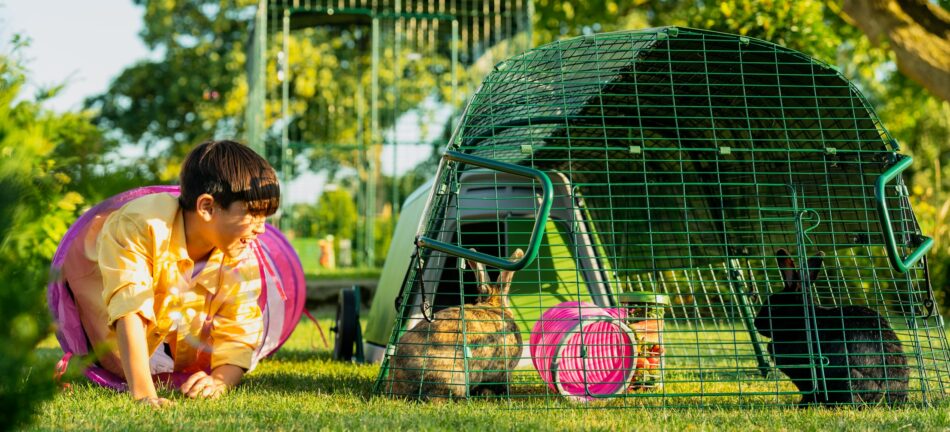
Wondering how to pick the right hutch for your rabbit or guinea pig? It’s easy to get bogged down by all of the choices available for potential and current cavy or rabbit owners. We’ll help you decide how to pick the right home for your small pets, and how to help them enjoy it to the fullest.
Picking the perfect hutch
There are some important factors to consider when picking the right hutch for your rabbit or guinea pig. The materials, size, and placement of their home will greatly influence how you care for your furry friends, so need careful consideration. With these guidelines, you’ll be able to select a hutch that fits all of your needs.
Indoor or outdoor
Rabbits and guinea pigs can be kept indoors, but they are just as happy outdoors in an insulated hutch with a spacious run to give them plenty of room to run and play. If left to roam the house, rabbits and guinea pigs will happily find cords, wires, baseboards, or other items to chew on. And while they can be litter box trained, you’ll likely be sweeping up fecal pellets on an hourly basis. An outdoor setup makes cleanup a breeze, and you won’t need to worry about your pets nibbling on something they shouldn’t.
Housing your rabbits or guinea pigs outdoors year round is not only possible, but made easy with insulated hutches. Rabbit and guinea pig hutch weather protection can be added as an additional layer of insulation during frigid temperatures, and run covers provide shade and protection from the rain.
It should be noted that not all rabbit breeds and guinea pig breeds will thrive outdoors — especially in extreme climates. Guinea pigs in particular are suited to a milder climate, whereas many rabbit breeds do well outdoors. However, bringing them in and out is not good practice, as they will acclimatize to one or the other and won’t cope well with sudden changes in temperature. Breeds that require careful observation when housed outdoors:
Rabbits
Guinea Pigs
Consider size
Rabbits and guinea pigs are very social animals, and need friends of their own kind. While you can keep rabbits and guinea pigs together successfully, they each have different dietary needs and require their own space, so it’s best to start out with one species at a time, and always in pairs. Spayed and neutered males and females are good pairings, as are same-sex pairings (though rabbits should always be spayed or neutered in same-sex pairings to avoid territorial scuffles).
A home for your rabbits and guinea pigs is much more than just a hutch for shelter and sleeping — they should also have a run large enough for them to run and play in. As with other pets, both rabbits and guinea pigs benefit from the most space possible. Providing extra space through Zippi Tunnel Systems and Zippi Play Pens gives you an opportunity to customize your pets’ setup and offer them plenty of space outside of their hutch without sacrificing safety.
Give yourself some space
Don’t forget to factor in spending time with your rabbits or guinea pigs when choosing their hutch. Give yourself plenty of space to access their food and water for easy refills, and space in the run to spend time with them. If crawling or reaching into a run won’t be feasible for you, consider adding a rabbit and guinea pig playpen to their setup for easy access and quality time together. A Walk In Run is also a great addition if you have space, as it makes spending time with your small pets particularly comfortable, and gives easy access for cleaning or for switching their set up around for variety in their play and exercise.
Materials matter
Traditionally, rabbit and guinea pig hutches have been made from wood. It’s a readily available, inexpensive material that gets the job done. But, over time wood will rot, shingled roofs will need repairing or replacing, and hardware cloth will pull away from wood staples. And, wood is a very enticing material for rabbits and guinea pigs to gnaw on, which poses a risk not only to the structural integrity of the hutch, but to your pets’ health as well. Treated wood can be toxic when ingested, and splinters or large pieces of wood can cause obstructions in your pets’ digestive tract. Wood also absorbs ammonia from urine, and is difficult to keep hygienic, even with lining such as card or paper, as this too will soak through and be shredded by busy paws.
Plastic rabbit and guinea pig hutches don’t rot, warp, need re-roofing, or pose a gnawing risk to your pets. They’re weather resistant, don’t absorb moisture or odours, and can last a lifetime. And, instead of hardware cloth held in place with staples, the attached runs of Omlet’s rabbit and guinea pig hutches are made of heavy duty welded steel mesh that are held in place with strong, weather resistant clips. The Eglu Go Rabbit and Guinea Pig Hutch is easy to clean, and can be moved with ease with the addition of optional wheels and handles. Over time, this makes opting for an Eglu Go a great investment – financially but also in terms of time. With a slide out try you can simply wipe clean, you will be able to keep their hutch shipshape in a matter of minutes.
Accessorize their home
Once you’ve picked out your rabbits’ or guinea pigs’ hutch and run, it’s time to accessorize. Elements like treat holders, Zippi Platforms, and shelters and play tunnels are all ways to keep your small pets entertained, engaged, and enriched in their environment. They also help you interact with your pets on a whole new level, and build the bonds between you that last a lifetime.
Omlet and your rabbits and guinea pigs
We didn’t want ordinary hutches for extraordinary pets — so we created rabbit and guinea pig products that defy the norm. Our products also aim to bring you closer than ever to these animals that have captured the hearts of so many. From easy to clean hutches, spacious outdoor runs, and the one of a kind Zippi tunnel system, you’ll be amazed at how fun and intuitive it can be to interact with your rabbits and guinea pigs.
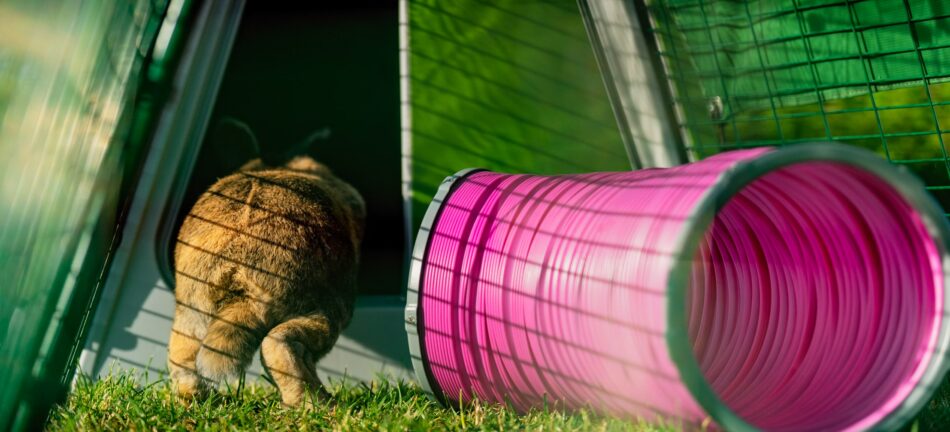

This entry was posted in Guinea Pigs
“We do a running commentary of what we think they’re saying – we have a laugh as a family.”
Ready to make room for rabbits? Shell Mills takes us through a day caring for these adorable yet naturally anxious animals.
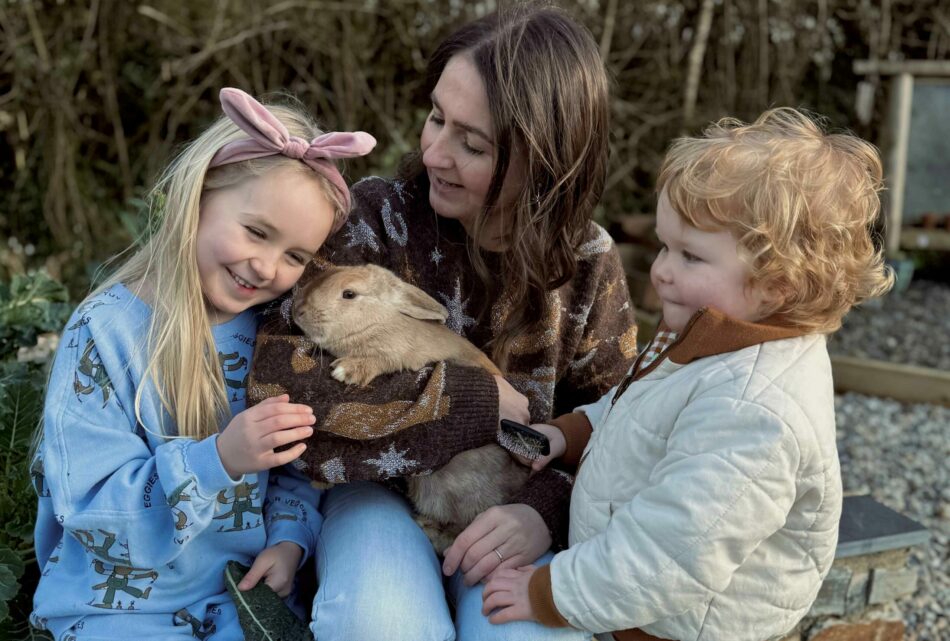
In a cat and dog world, what made you pick rabbits as pets?
Well, we have got a dog actually, but my first pets were rabbits and I always loved them. My husband and I had a dwarf lop together too, before we had kids. Then from about the age of five, our daughter, Valli began asking for one. We knew it was only a matter of time before we agreed. We thought she was too young – we said she had to be able to be responsible first. We said seven, then the years flew by and suddenly she was seven, so we had to say yes!
I bet she was thrilled! How did you go about getting them?
We made it a surprise – we’d been trying frantically to find some that would be old enough at the right time to tie in with her birthday. We’d researched reputable breeders and sources and we knew our local garden center had some coming, but they arrived when we were on holiday, so we had to get in touch from abroad to reserve ours.
The next step was buying a hutch – but I already knew we would get an Eglu Go. Our local primary school had an Omlet coop for their chickens – and I loved it. I looked online and once I knew Omlet made rabbit hutches, my decision was made. We managed to set them up in their Eglu for her birthday. It’s fantastic. We move their whole set up around and they save us from mowing the lawn! We often talk about chickens too – we might get some down the line!
What did she name them?
Bagel & brioche – after her favourite bread products!
Brilliant. And how does she get on with caring for them? There’s a misconception that rabbits are low maintenance – actually, they need a fair bit of looking after and are very sociable.
Yes, that’s true. Well, we definitely didn’t jump into it – it had been ten years since our dwarf lop and we did a lot of research. It’s better understood now that you shouldn’t have one rabbit – you need to have two, ideally from a young age to help them bond. They need daily attention too – they thrive on contact and are so playful and sociable.
There were other factors we hadn’t considered initially too – yearly vaccines, pet insurance, neutering or spaying – people might think it’s just a rabbit, but they come with responsibility and costs. There are so many extras. Then there’s what to do when you go away – we’re lucky, we have my parents nearby and they help us out.
What advice would you give to prospective rabbit owners?
Well, to do your research and understand their needs. You need to clean them out frequently – the Eglu is a real game changer in that sense. But also, consider all the costs and time you’ll need carefully before you commit.
What are the best bits about having rabbits?
I asked Valli these questions, as I wanted her input and her answer was, they are so cute, and they give the best cuddles! I do think it’s great to teach kids responsibility – how to care for something every day, when it’s sunny and when it’s raining. Vali is great with them and has a routine. She even brings in their water bottle to clean it with a little brush.
I think something you might not think of beforehand is the pleasure of just observing them – we love watching the two of them together. They’re so clever and the way they play together is just lovely. It’ll be wet and chilly, but they love being outside anyway, and they’ll be all cozied up under their run cover, sniffing the air, watching the rain. We do a running commentary of what we think they’re saying – we have a laugh as a family.
Whenever we go out, they come running over. Valli gets inside their run with them – it’s great for that. Not all rabbits enjoy being handled, but ours always have been and they’re so relaxed with it and will sit and cuddle peacefully on your lap. Our dog, Percy was a bit excited when we first got them, but he’s so unbothered now; he’ll potter over and they hop up and then they touch noses through the run!
Ha! That is very sweet. So, what does a typical day caring for the buns look like?
Bagel and Brioche start their day with Valli or Daddy going out to feed them, which means a small amount of pellets, topping up their hay, and giving them fresh water.
They have an attached Omlet run with an extension, so we see them running around throughout the day in the different sections. We just love watching them and seeing their movements, going through the tunnels and jumping on top of things – they love doing that.
Valli and our other children will go out and see them after school, and we go out again later to feed them and top up hay and water, but we don’t shut them in at night. It’s the great thing with the Omlet setup. With the underfloor mesh it’s fox proof, so they can come in and out as they please.
We refresh their bedding regularly and at weekends they come out into their open playpen and the kids go in there with them. That’s when we give their hutch a full, deep clean out. Sometimes they come into the house and explore while we’re doing that.
A few times a week Valli might take them treats from our vegetable garden. This time of year we only have broccoli and kale left, which they love. Then a couple of times a week we move them around the garden for a change of scenery! It’s a nice routine. Valli loves it all and does it happily – apart from sometimes, when it’s absolutely tipping it down! Then I step in and help out. They are her rabbits, but having pets is always a family activity really.


This entry was posted in Omlet meets
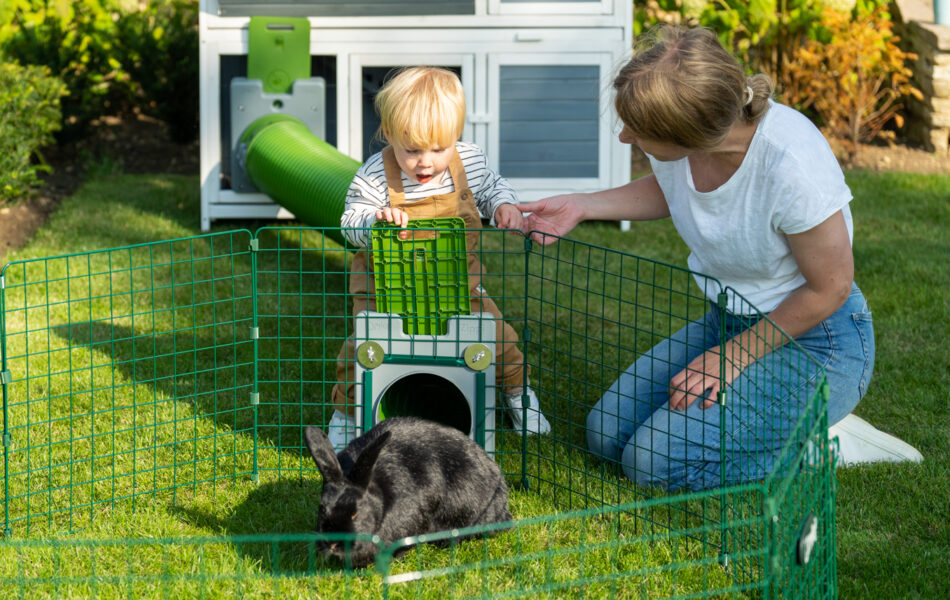
Thinking about adding a rabbit to your family? Rabbits make fun and interesting pets, and with the right setup and routine, they can live a long and happy life, bringing you joy for years to come. But there are a few things to know before getting a rabbit – from how many and what kind, to how they’re housed and what to feed them, here’s everything you need to know before bringing home a bunny.
Rabbits need a friend
First and foremost, rabbits are social animals that need the companionship of other rabbits. In the wild, rabbits live in large groups that form colonies, but domesticated rabbits are content with having just one friend. Opposite gender pairings introduced at a young age usually form the best bunny bonds, but it’s possible to slowly introduce two grown rabbits, or those of the same gender.
All male rabbits should be neutered, even if there are no females around. This is because males can become territorial and injure each other in testosterone-fueled duels. Similarly, all females should be spayed to help minimize moodiness and territorial displays. Spaying females also prevents uterine cancer and phantom pregnancies.
Once bunnies are bonded, they should never be separated unless absolutely necessary. This is especially true for same gender pairings, as they can become territorial when they are reintroduced – even after a brief time apart. Once bonded, rabbits that live together constantly will be very close, and you’ll be able to witness their adorable snuggling, grooming, and playtime antics.
Types of rabbits
There are several breeds of rabbits to choose from. Some have erect ears, while others have lopped (floppy) ears, some breeds like the Flemish Giant are large and some like the Netherland Dwarf are small. Breeds like Angora rabbits have long, thick fur, while breeds like the Rex rabbit have short hair.
Whichever breed or breeds you choose, make sure they’re suitable for your climate and lifestyle. Breeds with thick hair will tolerate cold temperatures much better than hot climates, and large rabbits need plenty of space to stretch their long legs. Select and research a few breeds you’re interested in, and then determine what type of setup your yard can accommodate.
Bunny behaviours
There are a few behaviours that bunnies have that new owners might not be prepared for. Here are some common characteristics and behaviours from rabbits that owners should keep in mind.
Digging
All rabbits dig. Bunnies have carried over their need to burrow from their wild ancestors. If allowed to do so, they will happily dig their own tunnels in your yard, their enclosure, or your carpet. All outdoor rabbit enclosures should have wire along the bottom to prevent your bunnies from tunnelling out, and they should never be left unsupervised while playing in the house. Dig boxes made with dirt, shredded paper, or other materials can be created for your rabbits for them to satisfy this urge.
Ever-growing teeth
Rabbits have teeth that never stop growing. Because of this, they need access to apple wood chews and timothy hay at all times. By gnawing and chewing on these, they’ll keep their teeth filed down and in check. If left to grow, a rabbit’s teeth can cause issues when eating and drinking, and can even grow into their jaw, creating painful puncture wounds and abscesses.
Thumping
This sound is unmistakable – two powerful rabbit feet coming down together in a very audible thump. It’s a quick sound made by your rabbit to let you know they are feeling threatened or uncomfortable. It doesn’t always convey aggression, but a thump is nevertheless a warning that they are not pleased with the situation they’ve found themselves in. Take caution with a rabbit that is thumping at you, and change tactics to make them feel more at ease.
Exercise
Bunnies need as much space as possible to run around and stretch their powerful legs. You may find your rabbit performing some theatrics like getting the “zoomies” – a sudden burst of energy on display by them running in a repetitive pattern. There’s also the bunny “binky”, which is an adorable twisting hop motion that some people also refer to as “popcorning”. These behaviours are the sign of a contented rabbit with an adequate amount of space.
A bunny abode
While you can keep rabbits indoors, they are much happier outside. Rabbits can be kept outdoors year round as long as the proper precautions are taken. With these essentials and some care from you, your outdoor rabbits can enjoy living as close to nature as possible.
A secure rabbit hutch with attached run
All bunnies need a hutch to sleep, hide, and shelter in during inclement weather. The Eglu Go Rabbit Hutch is designed to withstand any weather, and is twin-wall insulated to maintain a comfortable interior temperature. It’s also easy to clean, can be moved easily with the addition of optional wheels and handles, and is spacious enough for two rabbits to fit comfortably.
The Eglu Go is designed with an attached run with full mesh flooring, which prevents escape attempts via tunnelling and stops predators digging in. Our attached runs bolt onto the hutch itself, under the outer casing, and are made of heavy duty welded steel mesh, creating a fox proof environment. (Although, please ensure you check the clips over time to ensure all parts of the run are tightly closed together – over time, clips can weaken.)
Alternatively, you can place your Eglu Go inside our Walk In Run. There is no need to shut your rabbits inside the hutch compartment at night, unless in extreme cold weather (and depending on which breed you have, and their tolerance for cold). This way, they can set their own schedule and stay active during the night and before dawn, letting them live according to their natural biorhythm.
Rabbit runs and playpens
Your rabbits’ run should be large enough for both of them to run and exercise comfortably. Additional rabbit runs and playpens can be added onto your primary setup to provide even more space, connected by Zippi Rabbit Tunnels. This design closely mimics the burrowing system that wild rabbits use, and brings your domesticated bunnies closer to their natural habitat. Zippi Rabbit Platforms can also be added to their playpens to utilize vertical space and offer a shady reprieve below.
Bunny bedding
The bedding of your bunnies’ hutch should be a non-toxic, absorbable material. Most rabbit owners find that pine shavings or pellets, or recycled paper bedding are the best materials to use. Avoid using hay or straw with rabbits, as these hold moisture and promote mould and mildew growth.
Your rabbits’ hutch should be cleaned at least every other day, preferably with daily bedding changes. Once a week the entire hutch should be wiped or sprayed down, and the bedding completely refreshed. This is especially important during the warmer summer months when your rabbits are at most risk of rabbit flystrike.
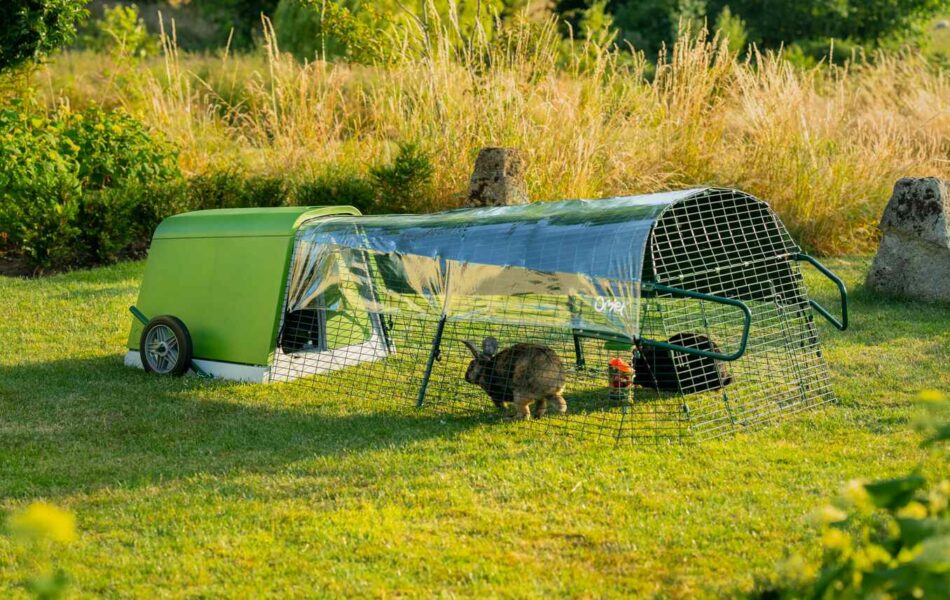
Feeding your rabbits
Rabbits need a quality pellet feed and timothy hay – which should be their primary source of nutrition. Hay should be left out free-choice and filled as needed, while pellets should be fed as directed by the packaging – roughly an egg cup a day per rabbit is a good guide. Rabbits will eat – and poop – constantly, and need the fiber in the hay to stay regular. They can become seriously ill very quickly if they stop eating and pooping, so it’s important not to overfeed them with pellets, as this can result in them not eating the necessary amount of hay.
Rabbit-safe fruits and vegetables can be offered as treats 2-3 times a week, but always in moderation. Leafy greens served in a Caddi Rabbit Treat Holder, non-starchy vegetables, and berries are the best choices. Fresh, clean water should also be available at all times for your rabbits.
Handling your rabbits
Some rabbits take kindly to being cuddled, while others are more content to receive scratches from ground-level. Either way, at some point it’s likely that you’ll need to handle your rabbit. The safest way to hold a rabbit is to angle their head so that it’s under your upper arm, with its nose pointed behind you. Tuck the rest of your rabbit’s body against your side, and secure them in a “football” hold with your lower arm and your hand wrapped around their hips. Always be mindful of your rabbit’s powerful back legs and sharp claws when handling them.
Veterinary care
There are no required annual vaccinations for rabbits in the US, and they rarely need deworming. But it’s still a good idea to have a veterinarian to contact if your bunnies ever feel ill or become injured. Not all veterinarians are equipped to treat rabbits, so be sure to select one that will treat your bunnies well before you bring them home. There are also elective vaccines for rabbits in some states to prevent contagious diseases – consult your veterinarian to discuss whether vaccinating your rabbits would be advisable.
Omlet and your rabbits
From easy to clean rabbit hutches and spacious rabbit runs, to ingenious and unique rabbit tunnel systems, we have everything you need to make your rabbit keeping journey both enjoyable and extraordinary. Create setups that are as unique as your rabbits, and build bonds with your bunnies that will last a lifetime. With Omlet, owning rabbits has never been more fun.


This entry was posted in Rabbits
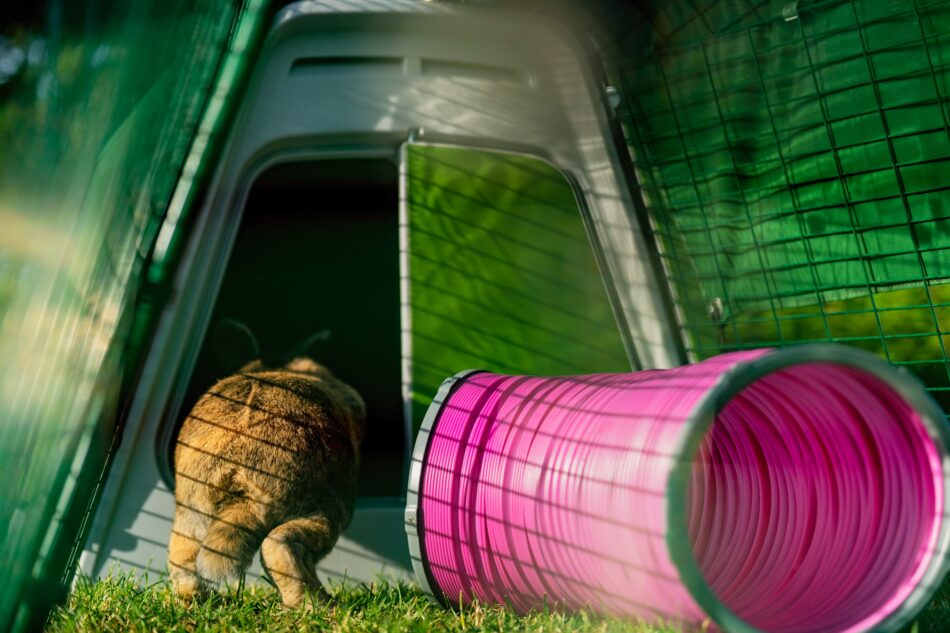
Rabbits make great family pets, and there are many different breeds to choose from. Some are easier to care for than others, making them ideal choices for beginners or children. Other breeds can prove more challenging to care for, but can be enjoyed by more seasoned rabbit-owners. So, which is the best rabbit for you? We’ll outline our top picks.
Children and rabbits
Although they make good pets for kids, rabbits might be disappointing as a first-time pet for young children. This is because most rabbits aren’t fond of being picked up and carried around, and can cause accidental injury to both themselves and children due to their powerful back legs and sharp claws. But, this isn’t to say that rabbits can’t be good pets for children.
Because bunnies need a gentle and practised hand, it’s best for parents or older siblings to be the ones handling them. Younger children can enjoy sitting with, petting, helping feed, and observing pet rabbits, making rabbits good pets for children of all ages.
5 best rabbit breeds to own
We aren’t trying to play favourites, but there are a few rabbit breeds that stand out as ideal choices for first-time rabbit owners. Their overall personalities, low-maintenance grooming needs, and basic housing requirements make these breeds great options for families.
Mini Lops
Big floppy ears, but with a compact, easy-to-house stature, Mini Lops are a favourite among first-time rabbit owners and breeders alike. They have outgoing personalities, and are known for being good with children. Mini Lops have short-medium coats that don’t require much grooming, and top out between 4.5-6 pounds. They’re easily trained and are social with other rabbits and humans.
Holland Lops
Similar to their cousins, Holland Lops have floppy ears and small bodies. Their faces are more flat than Mini Lops, and their ears are shorter and more rounded. Holland Lops weigh 4 pounds or less when they’re full grown, but have lots of energy. They’re social and enjoy interacting with humans and other rabbits, but need plenty of space to exercise. Because of their energetic nature, Holland Lops prefer to play with their owners rather than be carried around — but they’ll enjoy a good snuggle.
Lionheads
As their name suggests, Lionhead rabbits have tufts of hair encircling their heads that appear like a lion’s mane. While they do have extra hair that requires brushing from time to time, Lionheads have small bodies that weigh between 2.5 and 3.5 pounds when full-grown, making them perfect handling size. In fact, Lionheads are known as “lap rabbits”, and actually enjoy being held and handled. Their sweet, laid-back personalities make them a favourite among families.
Himalayans
Himalayan rabbits have a striking appearance — white bodies with dark points and pink eyes. They grow to be between 3 and 5 pounds, and have short hair that is easy to groom. Himalayans have long been appreciated for their calm and patient personalities. They don’t mind being handled, and are one of the oldest domesticated breeds of rabbits, making them well accustomed to human interaction. Himalayans are easy to train and care for.
Harlequins
A medium breed weighing up to 9 pounds, Harlequin rabbits are stunning in appearance and are curious and outgoing. They love learning tricks, and respond to praise from their owners. Harlequin rabbits should have plenty of space to expend their energy, and thrive off of human interaction. Their size may make them slightly more difficult for children to handle, but their desire to please makes it easy to train them to come when called and accept being petted and held.
Basic bunny care
No matter which breed you choose, all rabbits have the same basic needs. Before bringing your rabbit home, be sure to have:
All rabbit breeds thrive best when they’re given as much space to play and explore as possible. The addition of Zippi Rabbit Tunnels and Zippi Rabbit Playpens broadens your bunnies’ territory and fosters their natural desire to burrow, scurry, and play.
Bunnies need buddies
In addition to their housing, rabbits need companionship. Two neutered males, a neutered male with a female, or two females are all successful combinations. The younger the rabbit, the easier it will be for them to bond with another bunny, but it’s possible to introduce two grown rabbits for a lasting relationship. Rabbits are social animals, and their interactions with each other won’t interfere with the bonds made with their humans.
Consider adopting a bonded pair of rabbits, or obtaining two young rabbits at the same time when starting out. A lonely rabbit may become depressed or act out, so providing your bunny with a buddy will make it easier for you to build a bond with them.
Omlet and your rabbits
Building bonds between you and your bunnies is at the forefront of our designs. Our Eglu Go Rabbit Hutch has everything you and your rabbits need to keep them safe and happy, while our line of Zippi Rabbit Tunnels and Zippi Rabbit Playpens enable you to watch and play with your rabbits in an environment that mimics nature — making your relationship with them as unique as their individual personalities.

This entry was posted in Rabbits

Thankfully, rabbits and flystrike aren’t a common pairing when bunnies are well cared for. Healthy rabbits that can groom themselves and have a clean environment are not easily affected by flystrike. But as prey animals, rabbits are very good at masking their discomfort – so it’s important to know what flystrike is, how to prevent it, and how to treat it.
What is flystrike?
Flystrike, also known as myiasis, is a condition where animals that live outdoors become infested with fly larvae (maggots). In rabbits, flystrike begins when Lucilia sericata (green bottle fly) lays eggs on their skin. When the maggots hatch, they take up residence on your rabbit – eating through the skin and eventually invading the deeper tissue beneath. As awful as this condition is, it’s not common in healthy bunnies. The majority of rabbits that suffer from flystrike are:
- Those that cannot groom themselves due to obesity or other illness
- Living in unsanitary housing conditions
- Soiled from urine or faeces, or wounded
If your rabbit’s coat becomes overly dirty (caked on droppings, urine-soaked, or constantly damp from the weather) or their living conditions become so soiled that droves of flies are drawn to them, they are at risk of flystrike. Flies are part of living outdoors and small numbers of these flying pests are not usually cause for alarm. But, when flies are attracted to the dirty, smelly coat of a rabbit in less-than-ideal conditions, trouble sets in.
Flystrike is most common during the summer months when flies are the most active. Warmer temperatures are hospitable for maggots, and flies are in abundance this time of year. And, with more rabbits laying in the cool grass or shade during the heat of the day, flies can easily seek them out. Bringing your rabbit indoors during the hottest part of the day may help abate the nuisance from flies.
Do indoor rabbits get flystrike?
Indoor rabbits can get flystrike, but it is much less common than if they lived outdoors. The same conditions apply for indoor rabbits to become affected by flystrike, and it’s less likely that those living indoors would have unsanitary coats or living conditions. And, houses tend to have fewer flies inside than the outside world.
Keeping your home clean with indoor rabbits is essential to avoiding flies. If you’re bringing your outdoor rabbits inside for brief periods during the day, make sure you’re not bringing flies in with them. Clean their indoor spaces daily to deter flies from accumulating.
6 signs & symptoms of flystrike in rabbits
Flystrike can occur rapidly, as maggots can hatch within mere hours of eggs being laid. Maggots seek out a food source as soon as they hatch, meaning your rabbit is in imminent danger of becoming a host for them. Bunnies may exhibit any of the following signs if they’re suffering from flystrike, so it’s important to perform regular rabbit health checks to evaluate their health.
1. Presence of maggots
The first symptom of flystrike is the presence of maggots. Fly larvae start out small and are worm-like in appearance. Flies lay their eggs on the part of the animal they are most drawn to. In the case of rabbits, this will usually be around the tail where urine and faeces are most likely to be present.
2. Lethargy
Your rabbit may appear listless or dull when they’re in pain. Flystrike causes extreme discomfort, so your bunny is likely to be less active and will be hesitant to move in most cases. Lethargic rabbits may also spend more time inside of their hutch.
3. Loss of appetite
Most animals (rabbits included) will be off of their feed when they aren’t feeling well. If your rabbit isn’t eating or drinking, there’s a good chance there’s something going on with them. Flystrike can cause a weakened or dehydrated rabbit to go downhill rapidly.
4. Increased digging
Agitated rabbits in pain may dig more in an effort to relieve their discomfort. Look for signs of your rabbits digging in corners in particular. Claw marks on the inside of hutches, outside in the run, or in bedding can be telling of a rabbit in pain.
5. Odour from enclosure
As you can imagine, flystrike causes a foul odour. The smell of the decaying flesh that the maggots leave in their wake is not a subtle sign. This sign usually occurs as flystrike progresses to a dire level.
6. Shock
The final stage of flystrike is shock. Shock sets in when a rabbit’s body is overwhelmed by pain, infection, or external stressors. Flystrike brings all of these conditions, making it very dangerous for rabbits. Symptoms of shock include:
- Rapid breathing
- Pale mucous membranes (eyes, gums)
- Seizures
- Unconsciousness or collapse
- Death
If you notice any maggots on your rabbit, or any of the above signs or symptoms, be sure to contact your bunny’s veterinarian right away. Prompt treatment is necessary to combat flystrike.

Which rabbit breeds are more prone to flystrike?
Any breed of rabbit can fall victim to flystrike, but some may be more susceptible than others depending on environmental factors. Lionheads or Angora rabbits have longer coats than other breeds that can become soiled quickly without regular grooming. Large breeds like the Flemish Giant are more prone to obesity due to their size, and overweight rabbits can’t groom themselves as thoroughly as bunnies that are the ideal weight.
How to prevent rabbit flystrike
Keeping your rabbit’s home clean is one of the most important and effective ways to prevent flystrike. Cleaning your rabbit’s hutch and refreshing their bedding daily in the summer is essential to combating flies. The Eglu Go Plastic Rabbit Hutch by Omlet can be thoroughly cleaned in just a few minutes each day, and has ample ventilation to prevent odours from building up. The expandable attached run gives rabbits plenty of room to run and lounge, spreading out their droppings to further deter flies from gathering.
For even more space to escape flies, our Zippi Rabbit Tunnel System can be connected to your hutch and rabbit playpen to create a larger area. You can also add platforms to playpens to encourage more exercise and prevent your rabbits from becoming overweight. Combined with a balanced bunny diet, Zippi Rabbit Platforms will help your furry family members stay in tip-top shape.
How to treat rabbit flystrike
Flystrike is a medical emergency and you should contact your rabbit’s veterinarian right away to prevent irreversible damage. Do not attempt to treat or remove burrowed maggots yourself, as pieces can break off inside of your rabbit and cause infection. Rabbits with flystrike will need prescription antibiotics and pain medication to make a full recovery.
Omlet and caring for your rabbit
Omlet’s rabbit products help keep your rabbits healthy and happy. Our easy-to-clean designs were created to help owners spend less time cleaning and more time playing with their pets. The Eglu Go Rabbit Hutch, Zippi Rabbit Platforms, and Zippi Tunnel System are all easy to keep clean, and encourage more movement from your bunnies to promote overall health. Combat flystrike and other dangerous conditions when you house your rabbit in expertly crafted setups by Omlet.
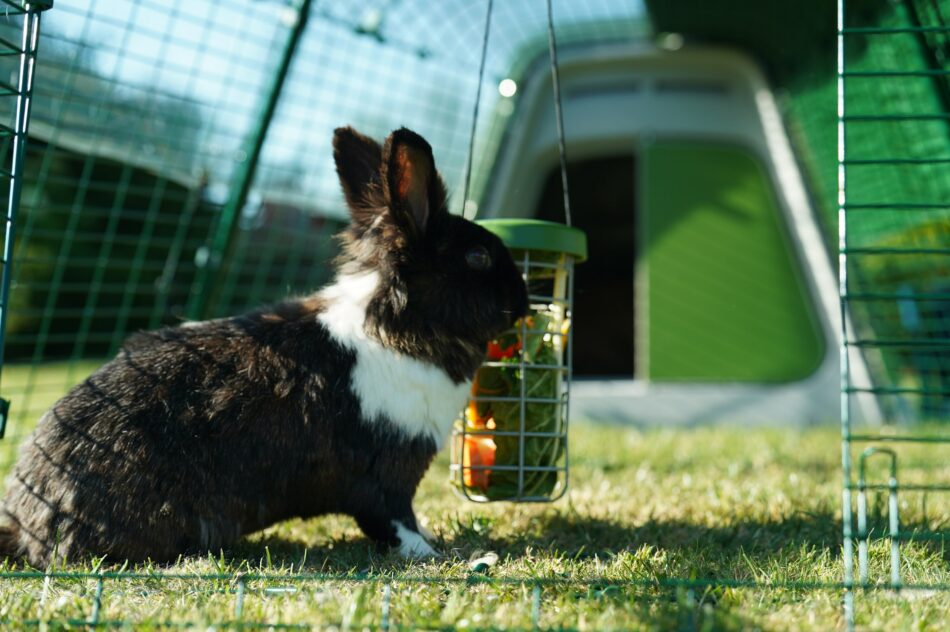
This entry was posted in Rabbits

With so many different species of animals to choose from, many parents find themselves asking: Are rabbits good pets for children? The short answer is yes, as long as there is mutual understanding between rabbits and their owners. Bunnies can be wonderful pets, full of personality and adorable antics when they’re able to exhibit their natural behaviours. With complete rabbit setups from Omlet, your children will begin bonding with their bunny right away, and for years to come.
Why rabbits can make great pets for children
Rabbits are intelligent, sociable, and relatively low-maintenance. These attributes are some of the reasons why bunnies make great first pets for children. Rabbits can be housed indoors or outdoors, but are happiest when they are provided with as much space as possible. In the wild, rabbits live in extensive underground burrows and tunnels – and their domesticated counterparts share the same desire to navigate these structures.
Omlet’s Zippi Rabbit Tunnel System simulates the tunnels and burrows that rabbits would construct in the wild. Combined with our Zippi Rabbit Runs and Platforms, your bunnies will be scurrying, bounding, and exploring just as they would naturally. And, you can let your children pick out rabbit run accessories to further customize their pets’ space.
Our Eglu Go Rabbit Hutches are the perfect size bunny abodes for both pets and children. The easy-to-clean structure will enable your kids to clean their pet’s home with ease, and will keep your yard smelling fresh. And, with optional wheels and handles, our Eglu Go hutches and attached runs can be manoeuvred around the yard with ease.
Creating a rabbit’s ideal space is just one of the many ways to bond with your bunny. Our rabbit products are designed to bring you and your bunny closer than ever. With the right setup and some quality time, your family will have forged a relationship with your rabbit that will last a lifetime.
Rabbits and children: 3 things to consider
While it’s true that rabbits can make excellent first pets, it’s important to set realistic expectations for both your bunny and your children. Make sure your kids are prepared for the responsibilities associated with owning a rabbit, and are familiar with bunny behaviours and body language.
1. Bunnies should have buddies
Rabbits do best in groups of two or more. In the wild, colonies of rabbits can consist of anywhere from two to dozens of bunnies. A lonely rabbit can act out or display attention-seeking behaviours. Adopting a pair of bonded rabbits is the best way to start off on the right foot, but you can also adopt young rabbits to raise together. Make sure that any males are neutered – even if you only keep males. Intact male rabbits can become territorial when kept together, and unaltered males kept with females will result in unwanted litters. Intact females can usually be kept together with no issues.
2. Rabbits are a long-term commitment
The life expectancy of rabbits is 8-12 years, so they can be a long-term commitment. Make sure plans are in place for when your children and rabbits are older. Will they take their pets with them when they move out? Do you have younger children to care for the rabbits once their siblings are grown? Or, are you willing to continue caring for the rabbits yourself?
The Eglu Go Plastic Rabbit Hutch is the only home you’ll need to buy for your rabbits. Designed to last a lifetime, our rugged construction of heavy-duty plastic and rot-free materials will stand the test of time. It should be noted that only rabbits over the age of 6 weeks old should be housed outdoors. Younger rabbits have more trouble regulating their body temperature, and will fare better when gradually introduced to outdoor temperatures. This also applies to older rabbits that were raised indoors. Introduce rabbits to life outdoors in small increments over the course of a couple of weeks to make the transition as smooth as possible.
3. Bunnies need boundaries
Any rabbit can be housed outdoors, and most fare better when they’re allowed to live outside. Not only does it mimic their natural habitat, but being outside gives them reprieve from the hustle and bustle of a household. Understanding your bunny’s body language will clue you in on how they’re doing in their surroundings. And, as with most pets, giving your rabbits as much space as possible will help ensure they’re healthy and happy as possible.
Omlet’s Zippi Rabbit Playpens help create boundaries for your bunnies in any setting. Perfect for designated spaces outdoors, or as indoor playpens for a change of scenery, our Zippi Playpens are easy to move and are predator-resistant for peace of mind.
The attached run of the Eglu Go Rabbit Hutch can also be extended to up to 12 feet long, giving your rabbits plenty of room to roam.
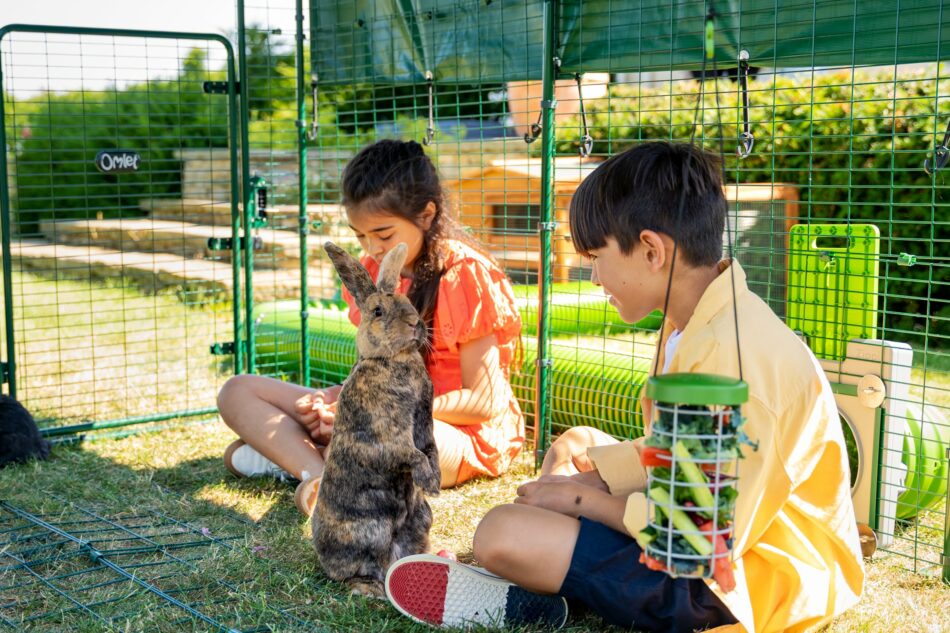
Best rabbit breeds for children
Once you’ve decided that rabbits will be a good fit for your family, it’s time to decide on the breeds of bunnies you’ll want to keep. Choosing the right rabbits largely comes down to personal preference and your space or climate.
For example, breeds like the Lionhead rabbit are excellent for children due to their docile nature, but may not be suited to life outdoors in hot or humid weather. Californians are considered to be a hardy breed in all climates, as well as being known for their sweet temperaments. Other breeds that are good for children include:
- Holland Lops
- Rex rabbits
- Mini Lops
Flemish Giants also make excellent pets, but due to their size require plenty of space.
Omlet and your pet rabbit
Omlet aims for owners to raise their rabbit-readiness status quickly and easily. Our line of bunny products like the Eglu Go Rabbit Hutch, Zippi Rabbit Playpens and Platforms, and Zippi Rabbit Tunnel System are all designed to make rabbit ownership truly remarkable. At the end of the day, parents have to ensure that their children are caring for their pets properly, but with Omlet, helping your children with chores becomes a joy. With Omlet, you’ll bring your entire family closer together – both with each other and with your pets.
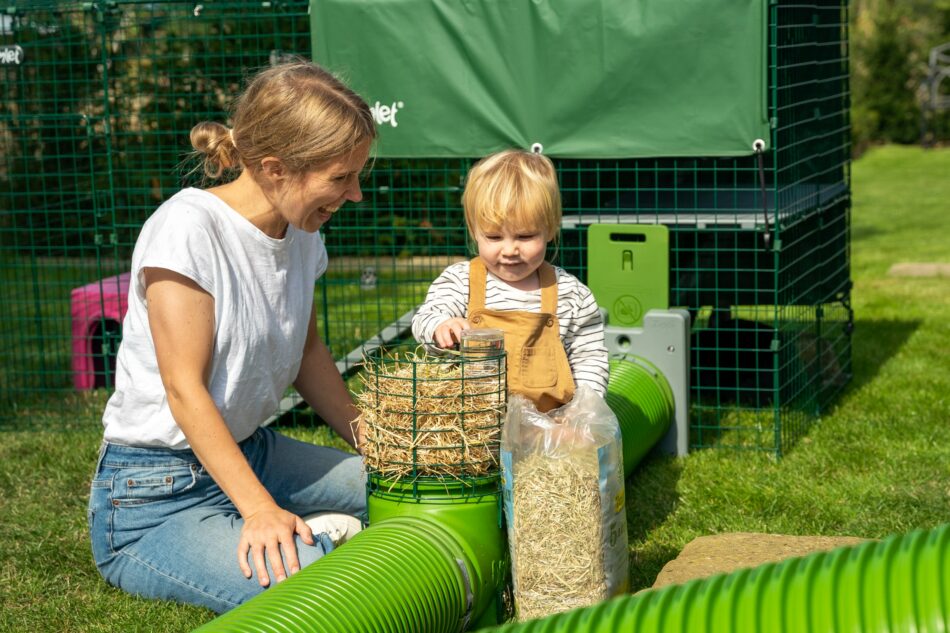
This entry was posted in Rabbits
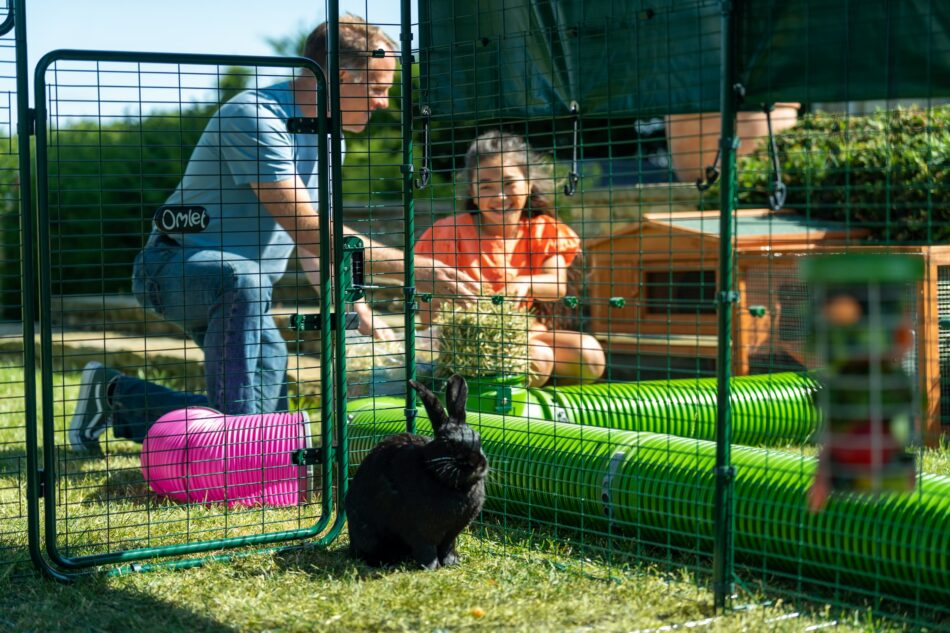
Keeping rabbits for beginners doesn’t have to be intimidating. In fact, these gentle animals are perfect for first-time pet owners due to their relatively easy care. With the right rabbit setup and research, you’ll be bonded with your bunny in no time.
Which rabbit breed?
There are many breeds of rabbits available as pets. They vary widely in appearance, size, and temperament. Some require more maintenance than others, mostly because of their long coats and heat or cold tolerance.
For example, Lion Heads have long coats in need of regular brushing to prevent mats from forming. They also aren’t as heat tolerant as other breeds due to their excess hair. On the other hand, breeds like the Californian are very heat tolerant and have short haircoats that don’t require grooming.
Rabbits may have erect or “lop” (long, floppy) ears. The anatomy of their ears doesn’t affect them much, except in the case of breeds like English Lops, as they are prized for their very long ears. These large, long-eared rabbits may be more prone to stepping on their ears in enclosures that are too small for them.
The breeds considered to be best for beginner bunny keepers include:
- Mini Rex
- Holland Lop
- Harlequin
- Lion Head (so long as they are groomed regularly)
The type and age of the rabbit you choose is largely a matter of personal preference. Most breeds have the same basic care needs, but be sure to research the breeds you’re considering thoroughly before making a final decision.
You’ll also want to decide if you’d like to start with a young bunny or an adult. Rabbits of all ages need to be handled regularly in order to bond with their new owners, but young rabbits may forge this bond faster than adult bunnies that have had previous owners. Like other pets, bunnies have their own individual personalities that may not be apparent right away. Give your rabbit time to adjust to their new home, and you’ll soon see their personality shine through.
How many rabbits should I get?
Rabbits are social animals that thrive off of bonds with each other. It’s always advised to keep at least two rabbits together to avoid a lonely bunny. In the wild, rabbits live in large groups called “colonies” and all live together in a network of tunnels and burrows called a “warren.” Colonies can consist of just two or three rabbits, or in the dozens.
Domesticated rabbits share many of the same characteristics as their wild cousins, so the need for companionship runs deep. Decide how many rabbits you’d like to keep together, which will determine how much space they’ll need to be comfortable. To avoid accidental litters, only keep neutered males with females, or stick to females only. If you plan to keep more than one male, they should all be neutered to prevent territorial displays.
Your new rabbits’ home
Omlet has created the perfect home for pet rabbits. The Eglu Go Plastic Rabbit Hutch is designed to meet all of your bunnies’ needs, as well as yours. Our easy-to-clean design keeps your rabbits fresh and clean and makes caring for your bunnies easier than ever.
Our plastic rabbit hutches have revolutionized rabbit-keeping. Gone are the days of rotting, moldy, smelly wooden rabbit hutches. With an Eglu Rabbit Hutch, you’ll never have to worry about maintaining the ideal environment for your bunnies.
Since rabbits need as much space as possible to keep fit and active, we’ve come up with several solutions that are conducive to any outdoor area. The attached run of the Eglu Rabbit Hutch can be extended up to 12 feet long, or your rabbit can explore new areas of your yard with an Outdoor Rabbit Run. Place your rabbit’s hutch inside of one of these rabbit runs, or connect the attached hutch run to the secondary run with our one-of-a-kind Zippi Rabbit Tunnel System. Designed to mimic tunnels and burrows in the wild, your rabbits will have their own backyard warren to keep them safe and happy all year round.
All of our rabbit products are predator-resistant, and feature optional anti-dig floor mesh to help prevent your bunnies from tunneling out. Optional handles and wheels can also be added to your rabbits’ hutch to move them around to fresh patches of grass, or shady areas of your yard.
New rabbit checklist
All pet rabbits need the same basic care and supplies. To complete your new rabbit checklist, be sure to have:
- A quality rabbit hutch to keep them comfortable and secure
- High-quality feed, ideally pellets comprised mainly of timothy hay
- Free-choice timothy hay
- Fresh water available at all times
- Chew toys to trim their ever-growing teeth
- A good veterinarian that’s familiar with rabbits
Bunnies thrive best when they’re given enrichment opportunities. Our outdoor rabbit runs combined with Zippi rabbit tunnels will help keep your rabbits’ minds and bodies active. Add weather protection to your rabbits’ run so that they can enjoy time out of their hutch – rain or shine.
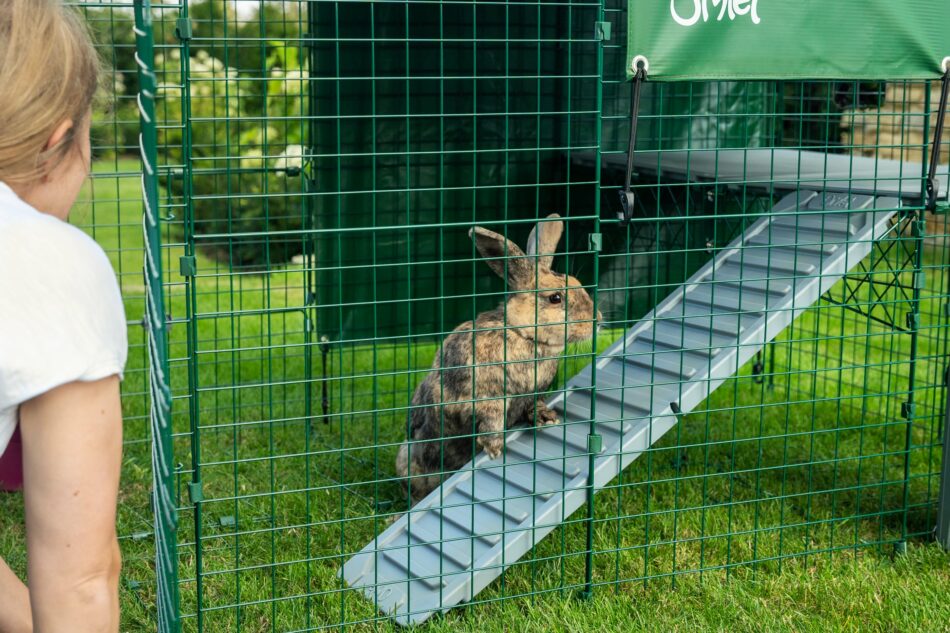
3 tips for beginning rabbit keepers
Excited to get started on your rabbit-keeping journey? Below are the top tips to help ensure success from the start.
Conduct rabbit research
Before bringing your bunny home, you’ll want to research the breeds you’re interested in keeping, along with their enclosure and dietary needs. Some breeds require more space than others, while some breeds have different protein requirements in their diet. It’s always recommended to find your rabbits through a reputable breeder. Breeders are excellent resources for first-time bunny keepers and can help you with the specifics of the breed you’ve chosen.
Establish a rabbit routine
Your routine with your rabbits will be unique to you as an owner, but a realistic schedule should look something like this:
Morning:
- Fill food bowl with pellets
- Refill hay feeder
- Refresh water bottle
Afternoon:
- Playtime
- Refill water if needed
Evening:
- Clean hutch and refresh bedding
If your rabbit has a long coat in need of grooming, you’ll need to make time to brush them a few times each week. Check your rabbits’ toenails monthly to see if they need a trim. Keep in mind that bunnies that have access to fresh earth will wear their nails down faster through play and digging than those kept in wire cages. If your bunny needs a nail trim, be sure you’re comfortable doing so on your own. Otherwise, your veterinarian can trim their nails for a modest fee.
Bond with your bunny
To have the best relationship with your rabbit, you’ll need to spend time with them each day. Once you get to know them, you’ll be able to understand your bunny’s body language. Handle your rabbits often to get them comfortable with you, and offer treats to reinforce desired behavior. Fresh fruits and vegetables are great rewards for training, as well as nutritious additions to your rabbit’s diet. Serve them in a Caddi Rabbit Treat Holder to keep your rabbit occupied in your absence.
Talk to your rabbits every time you interact with them to get them accustomed to your voice. Your bunny may be nervous the first few days in their new home, but with patience and care, you’ll earn their trust. Happy rabbits have clean, safe hutches, a well-balanced diet, and plenty of room to run around in. And, as any rabbit keeper will tell you, a happy rabbit is a joy to be around.
Omlet and your rabbit-keeping journey
Omlet’s rabbit products have been designed to keep rabbits and their owners happy — no matter where they are on their journey together. From seasoned rabbit owners, to complete beginners, our rabbit hutches, Zippi tunnel system, and outdoor rabbit runs bring joy to bunnies and their humans alike. You can rest easy knowing that your rabbits are living their best lives in their Omlet setup, and enjoy being a rabbit keeper with our easy-to-clean, zero-maintenance rabbit products.
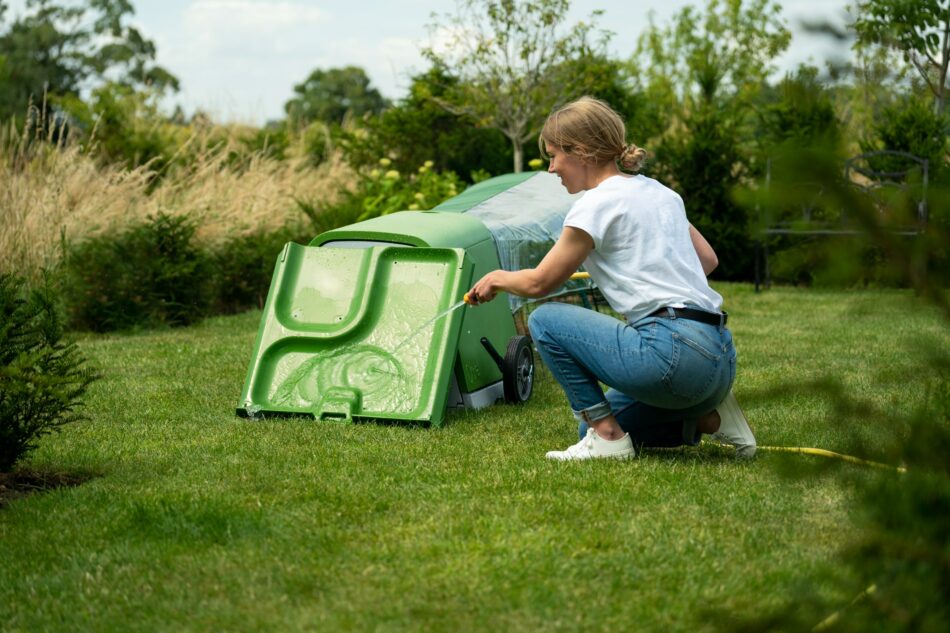
This entry was posted in Rabbits
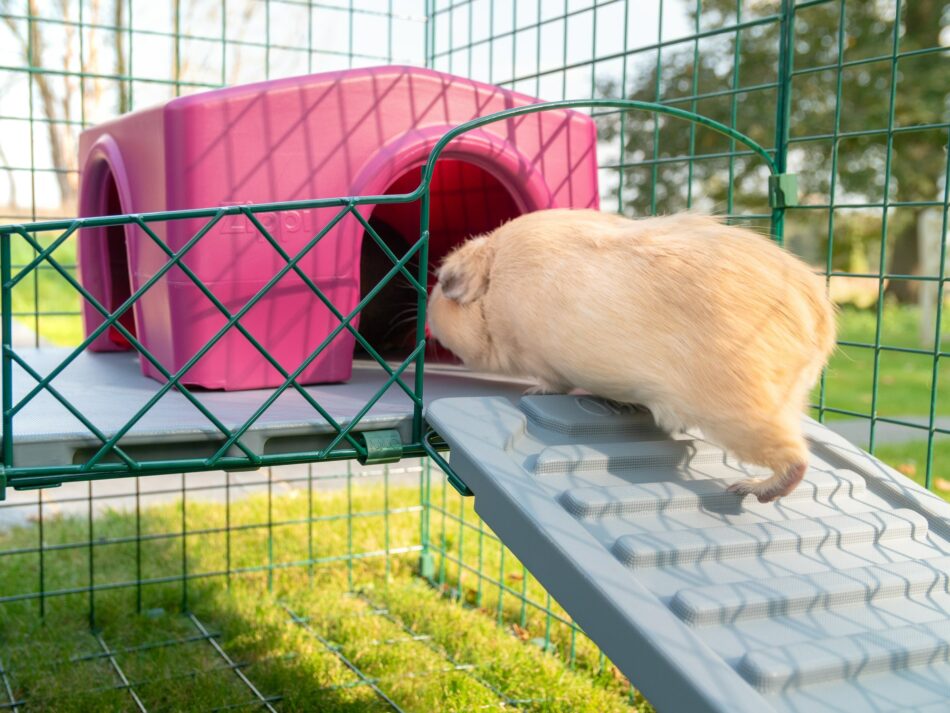
Rabbits and guinea pigs need exercise – and lots of it. Bunnies and cavies can become bored quickly without enough physical and mental stimulation, and a lack of activity can create these small pets to gain an unhealthy amount of weight. Adding levels to your rabbit or guinea pig’s enclosure through the use of platforms encourages more exercise and builds strength.
Physical and mental well-being
Exercise is important to rabbits and guinea pigs to keep them both physically and mentally fit. Keeping small animals at an appropriate weight is essential to their longevity. Accomplished through a balanced diet and plenty of space to be active, a rabbit or guinea pig kept at a healthy weight will remain active far longer than their overweight counterparts.
Omlet’s Zippi Platforms for rabbits and guinea pigs are designed to add extra space to your pet’s run. More space in their enclosure offers more opportunities for enriching activities and accessories. Teach your bunny or cavy new tricks on their platform to further stimulate their critical thinking skills.
Prevent the risk of injury and obesity
Rabbits and guinea pigs that spend the majority of their time in their enclosures aren’t able to exercise as much as their cousins in the wild. Wild cavies and hares run long distances, burrow, scurry, and don’t have constant access to food. Our pets that descended from these wild animals have slower metabolisms as a result of breeding and circumstance and rely on care from their owners to remain fit and healthy.
The use of ramps to access Zippi Platforms strengthens muscles and offers mental stimulation. Our platforms can be easily repositioned for rabbits especially to add more height. By exercising at an incline, your rabbit or guinea pig will utilize their muscles in ways that a one-dimensional enclosure can’t offer.
Overweight pets are prone to joint pain, health issues such as diabetes or other metabolic diseases, and decreased lifespan. Regular veterinary checkups can help you determine if your rabbit or guinea pig is receiving adequate nutrition and exercise. You can also do a quick check at home to see if your pet is overweight by gently pressing along the sides of your rabbit or guinea pig’s abdomen. Can you feel their ribs? You should be able to feel the distinct ridges of your pet’s ribcage without having to press too firmly. If you can’t feel their ribs, they’re likely overweight.
Along with exercise, diet is critical in keeping your rabbit or guinea pig healthy. Offer high-quality pellets that are timothy hay-based, and offer free-choice loose timothy hay or orchard grass. Treats should be given sparingly, and should consist of fresh greens rather than store-bought treats. Other guinea pig and rabbit-safe treats can be offered, but are best utilized during training sessions or other special occasions.
Platforms: a multitude of possibilities
Rabbits and guinea pigs grow bored easily in their surroundings. By adding platforms to their run, the topography of their environment can be changed regularly. Try feeding them on their platform one week, and below the platform another week. You can also place their favourite bed or toy at the top of the platform to encourage climbing up and down the ramp.
Small pets are also prey animals, which means they appreciate a higher vantage point. Your guinea pig or rabbit will appreciate the opportunity to scamper and scurry to the top of their platform to get a new look at their world.
Create the ultimate playspace for your rabbit or guinea pig. Omlet’s Zippi Platforms can be easily adjusted to a height that accommodates your pet’s personality and skill level. They can also be repositioned easily around the run to change up your bunny or cavy’s enclosure regularly. Our non-slip design builds confidence in your pets, allowing them to navigate the ramps and platforms with ease.
An easy way to have fun together
An elevated space in your rabbit or guinea pig’s run gives you a chance to interact with them on a higher level – literally! Sit with them at eye level, train on a flat and accessible surface, and customize their run with the use of Zippi Platforms. A designated training space will help you train your rabbit or guinea pig to perform tricks, giving you a clear, easily accessible area to work with your pet.
The first training opportunity you’ll find with your rabbit or guinea pig is getting them comfortable with their ramp and platform. Offer your rabbit or guinea pig’s favourite treats in a Caddi Guinea Pig or Rabbit Treat Holder placed at the top of the ramp. This will be the easiest way to help your pet get the hang of going up to the platform – especially if they are food-motivated. Once they are comfortable using their ramp and platform, you can begin teaching your rabbit or guinea pig additional skills.
Omlet and your small pets
Omlet is dedicated to designing products that thrill both pets and their owners. From unique rabbit and guinea pig shelters, to our customizable and versatile Zippi Tunnel System, we’ve got what you need to create the ultimate experience for your small pets. Foster your rabbit or guinea pig’s natural instincts while providing a visually stunning enclosure to enjoy in your yard or garden. With Omlet, owning and caring for your pets has never been easier.
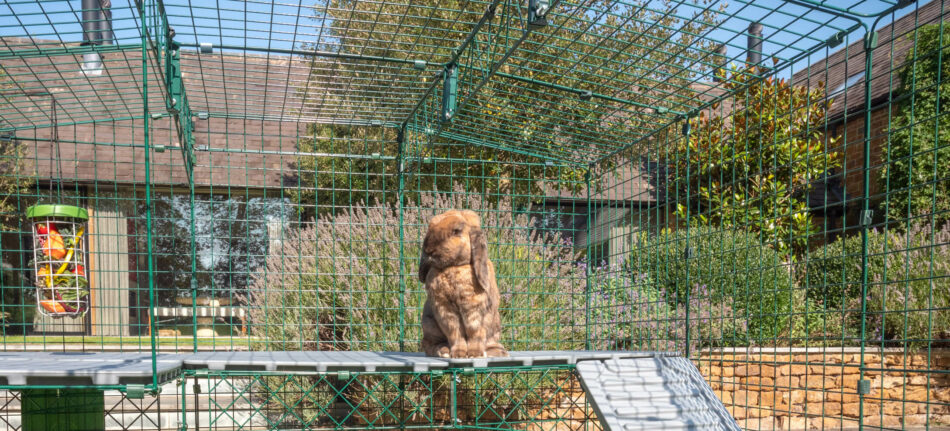
This entry was posted in Guinea Pigs

Rabbits make excellent pets for owners of all ages. Once you have all of the rabbit care essentials you need, bunnies are easy to take care of. They can be litterbox trained similarly to cats, are capable of bonding with their owners, and are a joy to watch. Like all pets, bunnies need love, attention, and proper housing to live a healthy and happy life.
Omlet has designed products that meet your rabbit’s needs, while making caring for them as easy as possible for you. Our line of rabbit products set you up for success with your bunny from the very beginning, and for the years to come. Let’s explore what life with rabbit products by Omlet looks like.
The perfect rabbit hutch
Does the perfect rabbit hutch exist? We think so! The Eglu Go Rabbit Hutch checks all the boxes for both bunnies and their keepers. Here are some reasons why:
- The dual-insulated walls of the Eglu Go Rabbit Hutch keep your bunny cool in the summer and warm in the winter
- All plastic construction and a removable bedding tray make cleaning a breeze
- An easy-access rear panel and pivoting hutch door keeps your rabbit accessible
- The attached run has anti-dig flooring and can be expanded for even more space
Plastic vs wooden rabbit hutches
Your rabbit’s hutch is where they will spend the majority of their time, so it’s important to choose the right one. There are a lot of rabbit hutch options out there, but a quality rabbit hutch should be safe, well-constructed, and built to last for years.
Plastic rabbit hutches are far superior to traditional wooden hutches. Most notably, rabbits have a natural desire to chew in order to keep their ever-growing teeth trimmed short. But, this spells trouble for wooden hutches, as they quickly become a chew toy for your bunny. Over time, chewing weakens the structural integrity of wooden hutches, which makes your rabbit vulnerable to unwanted visits from predators.
Omlet’s Eglu Go Rabbit Hutch will never succumb to rot like wooden hutches, and will never need touch-up paint or re-roofing. Plastic is not appetizing to rabbits, so you won’t have to worry about your bunny gnawing on their house. And unlike wooden hutch wire, our heavy-duty wire panels that make up the attached run are complete with mesh flooring to prevent your bunny from burrowing out of their enclosure.
Accessorize your rabbit’s home
Rabbits are extremely active animals. From wild hares to pet bunnies, rabbits need exercise and enrichment to stay physically and mentally fit. They need plenty of space to run, hop, and scurry, so you’ll need to give them as much room as possible.
Our Zippi Rabbit Tunnel System can extend your rabbit’s domain while fostering their natural burrowing behaviour. Zippi Tunnels can be attached to any type of wooden hutch or wire run, and have multiple customization options. Expand and change your rabbit’s Zippi Tunnel System at any time with connection pieces, additional tunnels, and accessories.
Add vertical space with Zippi Rabbit Platforms inside their run for maximum space-enhancing fun. Using platforms with your rabbits allows for training and exercise opportunities, as well as shady areas below for rest after a long day of play. Platforms are great places to keep your rabbit’s food and water, as they are accessible and easy to clean.
What about indoor rabbits?
If you choose to house your rabbit indoors, it’s still a good idea to have a safe space for them outside to stretch their legs. Bunnies love to nibble on fresh grass and other rabbit-safe vegetation. You can even add rabbit-friendly plants to your garden to make your bunny’s outdoor space even more enjoyable.
Our Zippi Rabbit Runs and Playpens are excellent options for rabbits to spend some time outside. Floor panels keep your bunny from burrowing out, while still allowing plenty of grass through to be nibbled on. And, Zippi Runs and Playpens are easy to move around your garden to give your rabbit new areas to explore.
Make sure your home is rabbit-proof if you keep your bunny indoors. Even if your rabbit isn’t left to its own devices indoors, if an accidental hutch escape occurs you don’t want them getting themselves into trouble. Common household hazards to rabbits include:
- Low-hanging power cords
- House plants, many of which can be toxic to rabbits
- Silk or artificial plants (if they look real, your rabbit is likely to try a nibble)
- Other pets such as dogs or cats
- Doors that lead outside
Rabbits are very adaptable to life outdoors, so unless your area experiences extreme heat or extreme cold, housing your rabbit outside in an Eglu Go Hutch and Run is a great alternative to keeping them inside. For extremely hot days, you may want to have a temporary indoor enclosure to bring your bunny inside during peak temperatures. In sub-freezing temperatures, supplemental Extreme Temperature Jackets for the Eglu Go Hutch can be used for an additional layer of insulation.
A good quality diet
Now that your rabbit has the perfect home, it’s time to select their feed. There are so many commercially available rabbit feeds that it can be overwhelming to choose which is best for your bunny. Knowing what breed of rabbit you have and how old they are will help you determine which food is best for them. For example, younger rabbits need more protein in their diet than adults.
All rabbits need quality pellets that are made primarily from timothy hay. Rabbit feed that has treats or other elements added in may look appetizing, but they don’t provide a balanced diet for your bunny. Rabbits also need free-choice timothy hay to keep their teeth short and to promote healthy digestion.
Food and water bowls
You’ll also need appropriate food and water containers for your rabbit. Metal feed bowls are best, as they are easily cleaned and can’t be chewed on or broken. No-tip bowls are a great choice, having a wide base and being harder to turn over. Some rabbits will hop into their food bowls while they eat, or accidentally knock into them during play, so having a bowl that won’t tip over is important.
Water bottles are one option for your rabbit to drink from. Most rabbits do fine with this type of drinker, but during the hot summer months, water bottles may not dispense water fast enough for a parched rabbit. Water crocks can be hung on the sides of your rabbit’s run to prevent spilling, and have an open top for your rabbit to drink their fill. You can also place a no-tip water dish inside their run, but keep in mind they will likely kick grass or other debris into a ground-level bowl.
Rabbit toys
Finally, offer some toys to your rabbit to keep them occupied and engaged in their setup. Toys are great for busting boredom and to encourage natural behaviours. Try offering small balls made from timothy hay, applewood chew toys, or a Caddi Rabbit Treat Holder from Omlet.
Hang the Caddi Treat Holder from the top of any run or enclosure to elevate snack time. Fresh fruits, vegetables or hay are perfect for the Caddi to serve up to your bunny. Watch as they stretch and use their critical thinking skills to nibble their way through their Caddi offerings.
Omlet and rabbit care
We’ve invented the products you need to grow your relationship with your rabbit. Our line of rabbit hutches, rabbit runs, rabbit tunnels, and toys for rabbits are all designed to help your rabbit live life to the fullest and to make taking care of them easy and fun for you. Create the ultimate bunny abode when you choose Omlet for your rabbit’s needs.
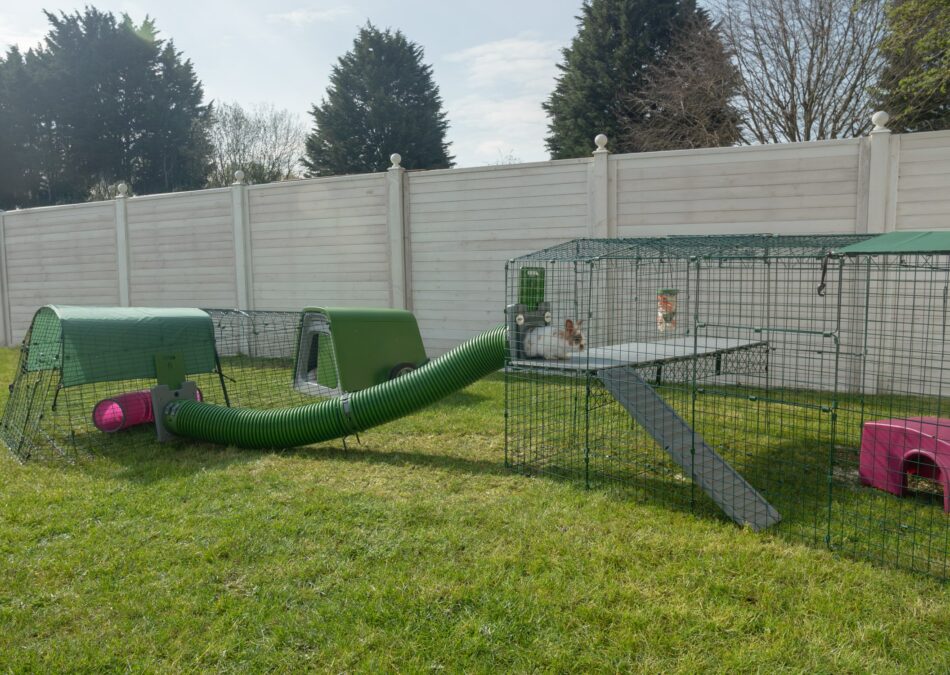
This entry was posted in Rabbits









































